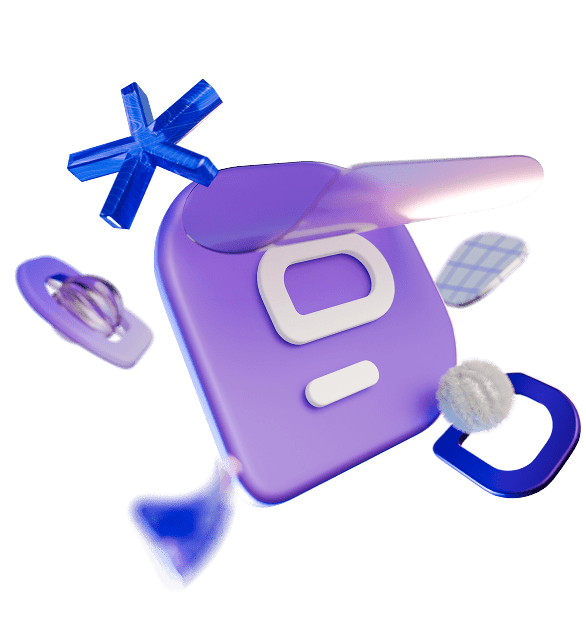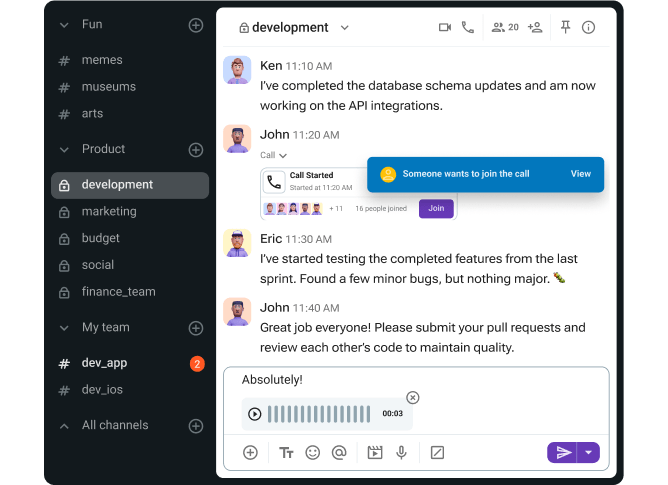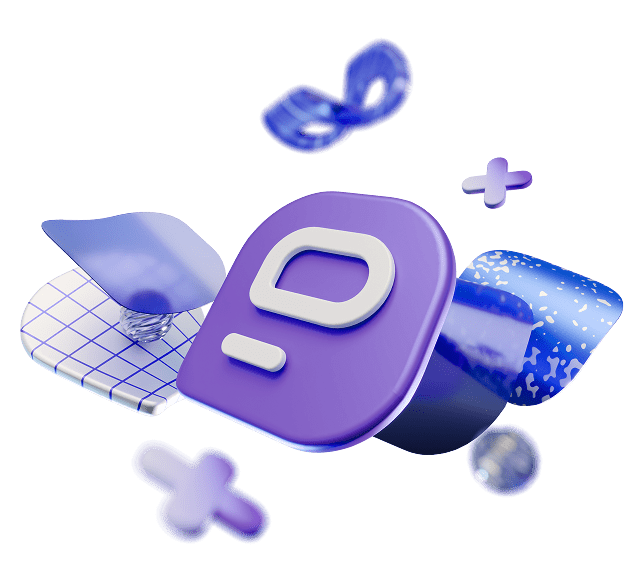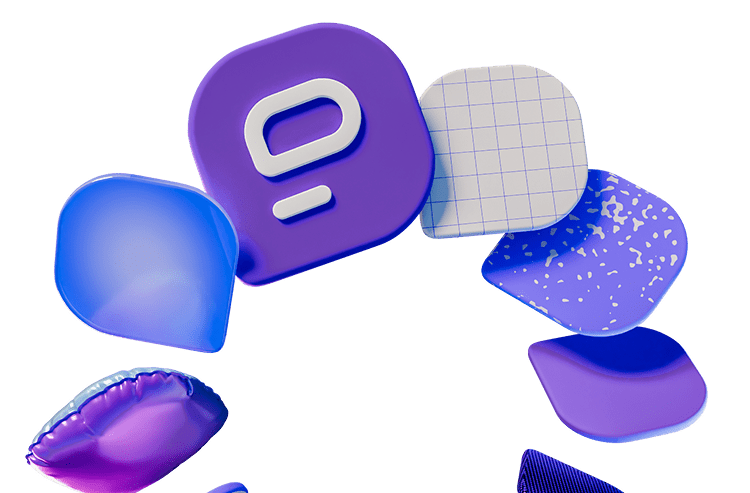La planification des cours, bien qu'elle est rarement privilégiée, est l'une des étapes les plus cruciales du processus d'enseignement.
Cependant, demandez à n'importe quel enseignant : nous sommes certains qu'il vous proposera une liste complète d'activités fastidieuses qu'il préférerait à la planification des cours.
Si vous faites partie de ces enseignants qui n'arrivent plus à suivre leurs plans de cours et qui ont désespérément besoin de réduire le temps consacré à leur création, nous sommes heureux de vous annoncer que vous êtes au bon endroit.
Nous vous proposons 36 modèles de planifications de cours couvrant pratiquement tous les cours, matières et types de cours dont vous pourriez avoir besoin. Vous n'aurez donc plus à vous soucier de rédiger un plan de cours de A à Z.
Avant de nous plonger dans les modèles de plans de cours, nous allons rapidement passer en revue la définition d'un plan de cours et en énumérer les principaux éléments.
C'est parti !
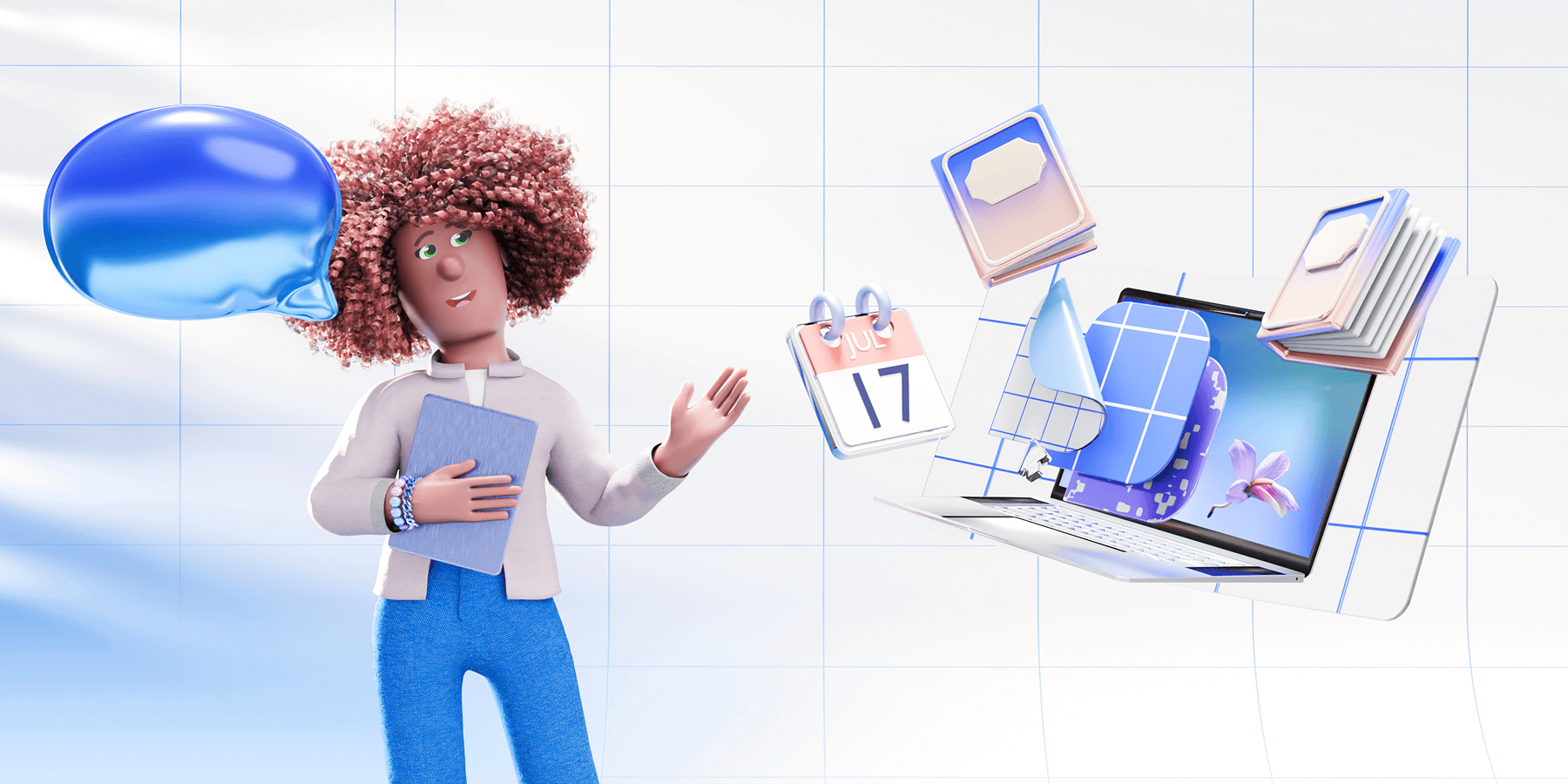
Qu'est que c'est la planification des cours ?
Un plan de cours est un document créé par les enseignants qui présente en détail les points suivants :
- Objectifs,
- Activités d'apprentissage,
- Matériel,
- Calendrier,
- Devoirs à la maison,
- Méthodes pédagogiques,
- Attentes de l'enseignant, et
- Évaluation.
Les plans de cours peuvent être établis pour une seule leçon, une journée, une semaine ou une unité complète. Le format du plan de cours dépend naturellement des exigences de l'établissement ainsi que de divers autres facteurs, tels que l'âge des élèves et la matière du cours.
Quelle est l'importance d'un plan de cours pour les enseignants et les élèves ?
Les avantages d'un plan de cours sont multiples, tant pour les enseignants que pour les élèves.
Lorsqu'ils sont bien conçus, les plans de cours aident les enseignants à :
- Assurer un cours fluide et productif,
- Assurer une bonne structure de leurs cours,
- Gérer leur temps et leur planification de manière impeccable,
- Assurer l'intégralité des points principaux des cours,
- Être préparé aux éventuelles désaccords,
- Préparer le matériel,
- Permettre l'auto-évaluation,
- Créer des plans réutilisables.
D'autre part, les élèves bénéficient également de plans de cours structurés de manière professionnelle, notamment lorsque les enseignants leur fournissent une version de leur plan de cours avant le cours.
Voici comment un enseignant peut utiliser Pumble, une application de messagerie instantanée, pour partager son plan avec un groupe d'élèves.
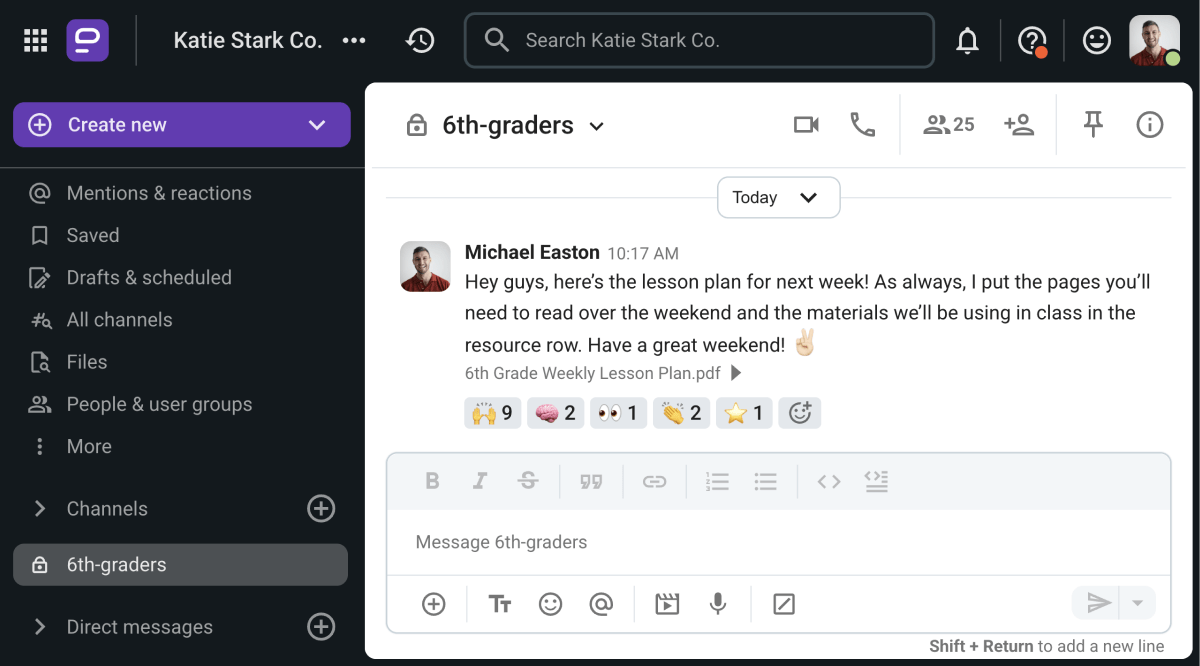
Créer une expérience d'apprentissage plus complète avec Pumble
Partager votre plan de cours à l'avance peut aider les élèves à :
- Comprendre à quoi s'attendre,
- Être au courant des sujets et des modules abordés, et
- Connaître le matériel nécessaire pendant le cours.
Bien que certains puissent affirmer que les plus jeunes élèves sont naturellement réticents à toute structure, Haley DeSousa, la responsable des programmes et de l'enseignement dans un centre d'éducation préscolaire, a expliqué qu'une planification efficace des cours est un guide précieux pour les enfants :

« Dans l'éducation de la petite enfance, la structure n'est pas synonyme de rigidité ; il s'agit de créer un rythme qui favorise la curiosité, l'engagement et le développement socio-émotionnel. Les plans de cours bien pensés permettent aux éducateurs de guider les enfants dans des expériences intentionnelles tout en restant attentifs à leurs besoins et intérêts en matière de développement. »
Mais, en fin de compte, les enseignants et les élèves ne peuvent bénéficier de ces avantages que si votre modèle de plan de cours est bien structuré.
Dans cet esprit, examinons quelques éléments clés de tout bon plan de cours.
Quels sont les éléments clés d'un plan de cours ?
Selon votre établissement, votre style et vos préférences, vous pouvez personnaliser et styliser vos plans de cours.
Cependant, quelle que soit votre approche, il est important de toujours garder à l'esprit les cinq principaux éléments d'un plan de cours et de structurer vos modèles de plan de cours autour de ceux-ci.
Les cinq éléments clés d'un plan de cours sont :
- Matière — le sujet sur lequel vous vous concentrez pendant la leçon,
- Conformité aux normes — s'assurer que vos leçons sont conformes aux normes nationales,
- Objectifs pédagogiques — les cibles que vous souhaitez atteindre et comment les élèves y parviendront,
- Procédure — toutes les activités et expériences d'apprentissage que vous pouvez organiser pour atteindre les objectifs d'apprentissage des élèves, et
- Évaluation — des tests et des exercices pour que les élèves mettent en pratique leurs compétences et leurs connaissances et que les enseignants fournissent le feedback constructif.
Disposer d'un modèle de plan de cours réutilisable incluant ces éléments clés peut simplifier la création de plans de cours tout en offrant plus de liberté aux enseignants, selon Annie Jenson, directrice des programmes d'une organisation à but non lucratif d'enseignement des sciences sociales :

« Grâce à un cadre solide, les enseignants peuvent intégrer de manière ciblée divers éléments, tels que le développement de la littératie, les activités de mouvement et les activités d'investigation, qui sont rarement privilégiés. Cette planification réfléchie favorise un environnement de classe où tous les élèves ont la possibilité de se développer sans que les éducateurs aient constamment à réinventer la roue. »
En d'autres termes, les enseignants peuvent se décharger de la planification des cours en trouvant des ressources en ligne de qualité, comme les modèles de plans de cours que nous allons partager !
Modèles de plans de cours pour les enseignants
Maintenant que nous avons abordé les éléments clés à inclure dans votre plan de cours, il est temps de parler des 36 modèles de plans de cours que nous avons préparés pour vous.
Vous trouverez certainement un format de plan de cours adapté dans l'une des 9 catégories ci-dessous, parmi lesquelles :
- Les meilleurs modèles de plans de cours en général (si vous cherchez un modèle simple pour commencer),
- Les modèles de plans de cours basés sur le temps (avec des exemples de modèles de plans de cours hebdomadaires et plus encore),
- Les 6 catégories de modèles de plans de cours par niveau institutionnel (incluant un format pour les enseignants du primaire, les établissements d'éducation préscolaire et même les universités), ainsi que
- Les modèles de plans de cours par matière pour toutes vos matières de base.
Pour chacun de nos modèles de plans de cours, nous avons créé une version modifiable et une version imprimable en noir et blanc.
Mieux encore, les deux versions sont entièrement gratuites et faciles à utiliser !
Alors, pour rendre la tâche de planification des cours un peu plus facile à gérer, trouvez le modèle de plan de cours qui vous convient et démarrez !
Catégorie n° 1 : Meilleurs modèles de plans de cours
Pour notre première catégorie, nous avons fait une liste des meilleurs modèles de plans de cours modifiables, applicables à de nombreux types de cours.
En fonction de votre cours et de votre type de classe, vous pouvez utiliser certains (ou tous) de ces exemples de plans de cours imprimables et modifiables, en les adaptant légèrement, et rédiger vos plans de cours en quelques minutes.
Modèle n° 1 : Modèle de plan de cours vierge
Pour commencer, commençons par le modèle vierge de plan de cours le plus universel.
Si nous commençons notre série de modèles de plans de cours avec celui-ci, c'est parce qu'il est extrêmement polyvalent et adaptable à de nombreux types de cours, matières, niveaux et périodes.
Choisissez simplement la structure de votre plan de cours et ajustez notre modèle de plan de cours vierge en conséquence !
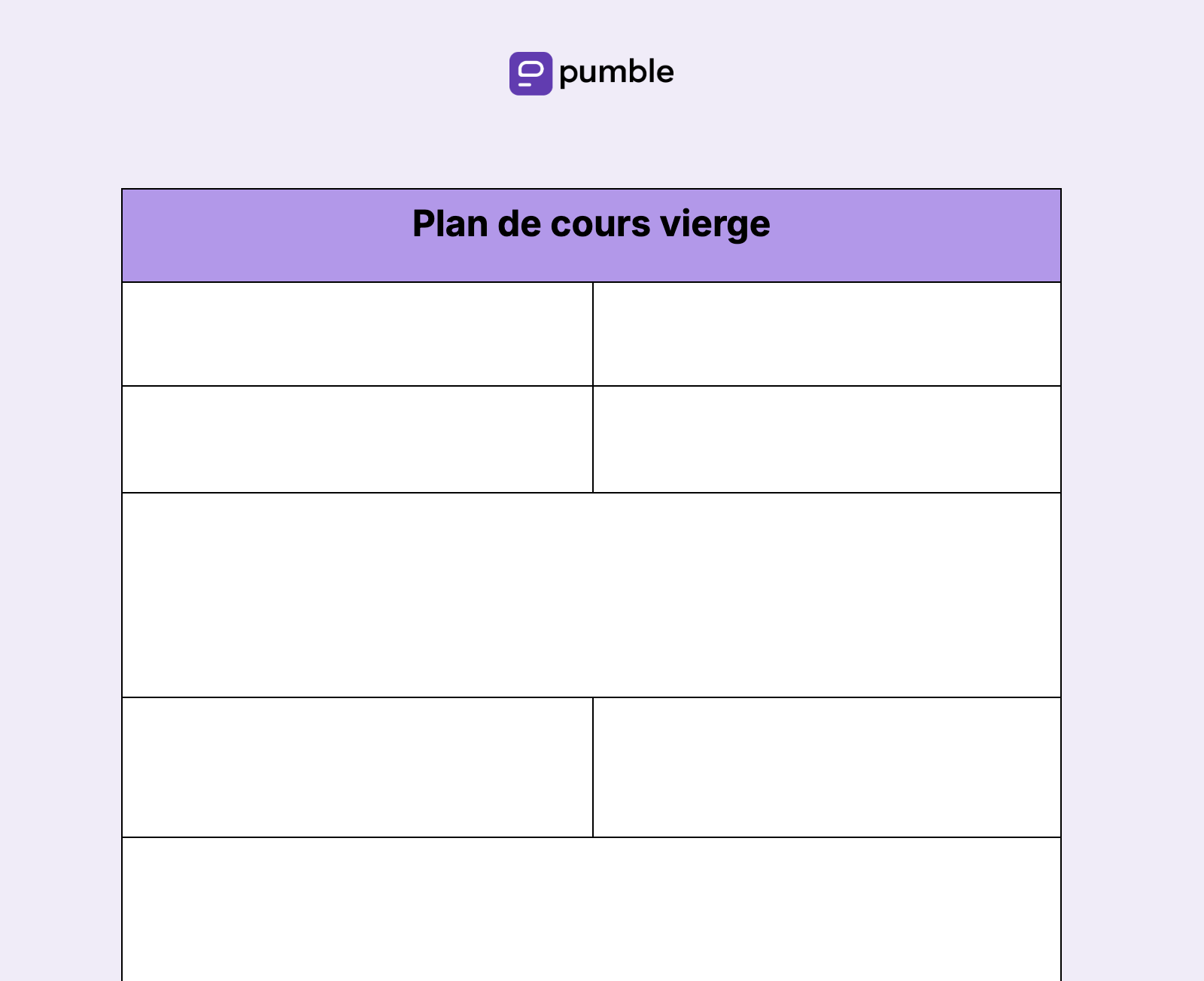
🔽 Télécharger le modèle de plan de cours vierge
🔽 Télécharger le modèle de plan de cours vierge imprimable
Utilisez un modèle de plan de cours vierge lorsque vous avez besoin d'un plan de cours simple mais super modifiable.
Partagez des plans de cours avec vos collègues via Pumble
Modèle n° 2 : Modèle de plan de cours simple
Notre modèle de plan de cours simple est idéal lorsque vous avez besoin d'un plan de cours rapide à remplir.
Utilisez le modèle pour créer votre propre modèle de plan de cours simple et utilisable à chaque fois que vous souhaitez aborder les bases d'un plan de cours.
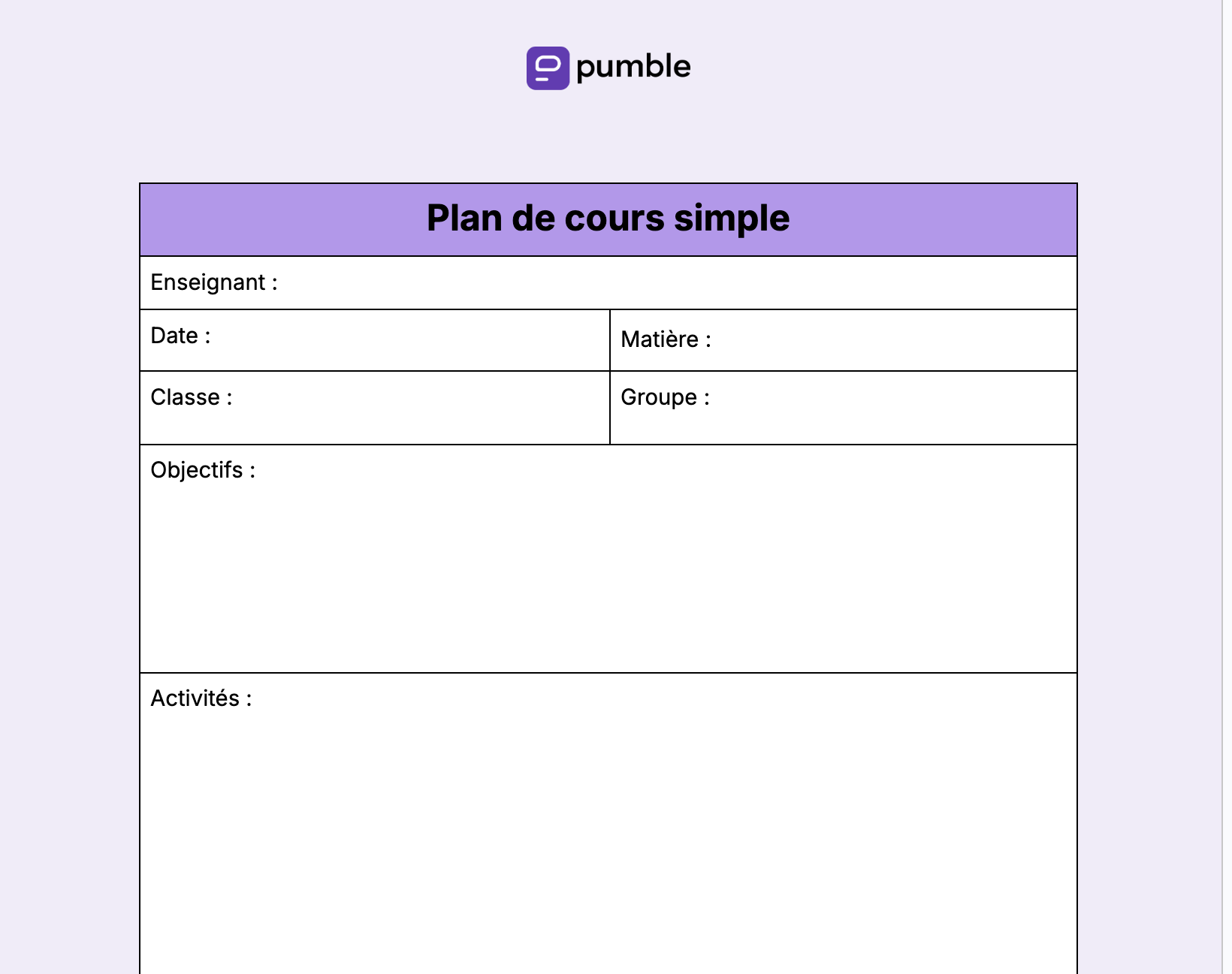
🔽 Télécharger le modèle de plan de cours simple
🔽 Télécharger le modèle de plan de cours simple imprimable
Modèle n° 3 : Modèle de plan de cours pour petits groupes
Enseigner à un petit groupe d'élèves nécessite une approche légèrement différente de la préparation d'un plan de cours pour une classe entière.
Après tout, les petits groupes permettent de se concentrer sur chaque élève en créant des opportunités pour :
- Une pratique suffisante,
- Une participation active de tous les membres du groupe,
- Des activités de travail d'équipe plus efficaces, et
- Un feedback.
Pour maximiser et encourager toutes ces opportunités en petits groupes, vous devrez personnaliser le format de votre plan de cours. Notre exemple de plan de cours modifiable devrait vous aider à équilibrer vos objectifs pédagogiques et les activités d'apprentissage de vos élèves.
Inspirez-vous de notre modèle modifiable pour personnaliser votre plan de cours, ou utilisez notre structure complète et imprimez vos modèles de plan de cours pour petits groupes complets.
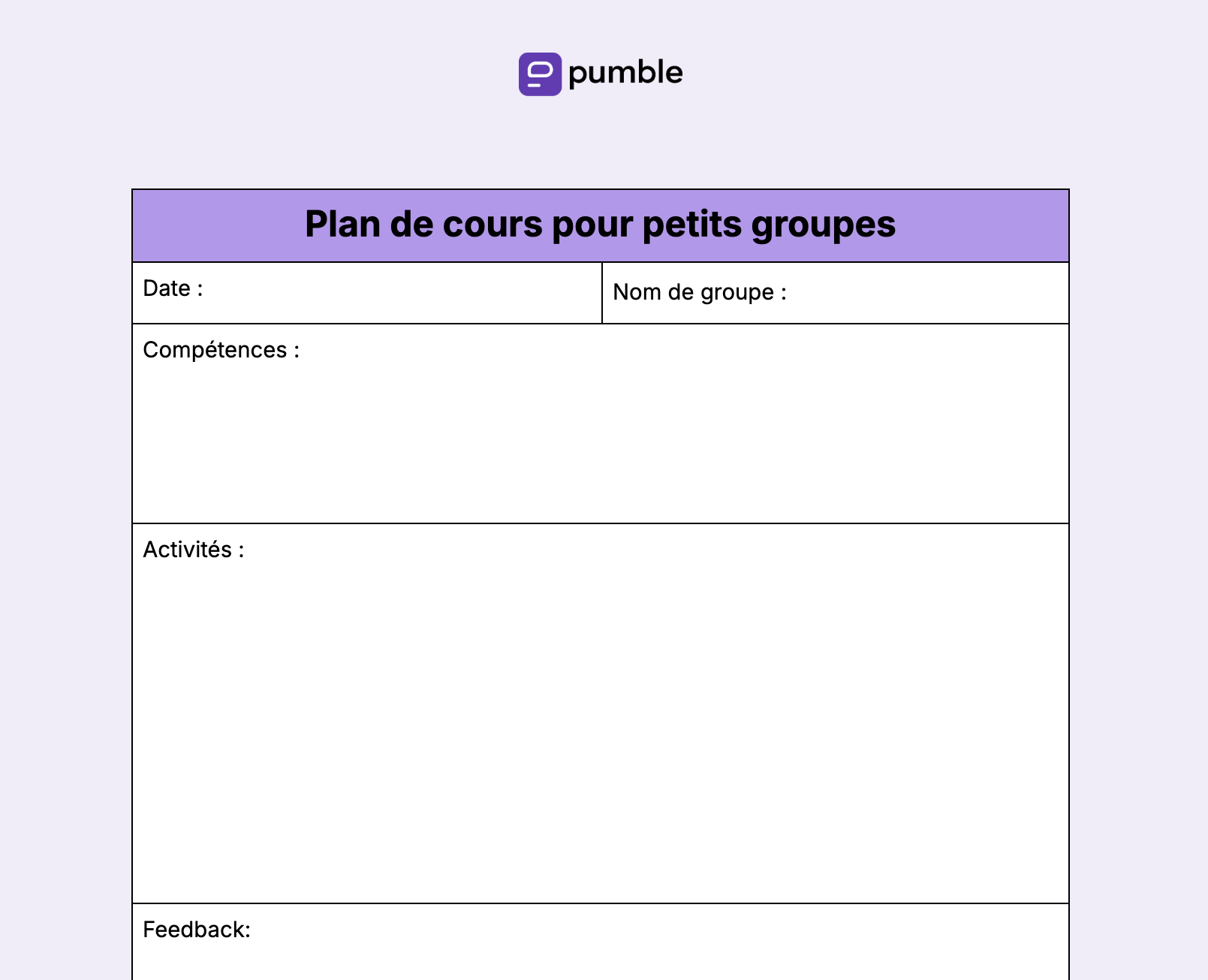
🔽 Télécharger le modèle de plan de cours pour petits groupes
🔽 Télécharger le modèle de plan de cours pour petits groupes imprimable
Organiser des cours virtuels pour de petits groupes sur Pumble
Modèle n° 4 : Modèle de plan de cours pour l'éducation spécialisée
Si vous travaillez dans l'éducation spécialisée, une planification de cours efficace implique de tenir compte des besoins spécifiques de vos élèves.
Outre la prise en compte des besoins et des capacités de chaque élève, la création de plans de cours pour une classe d'éducation spécialisée doit également :
- Définir des objectifs clairs,
- Favoriser un apprentissage actif grâce à des activités stimulantes,
- Garder à l'esprit les objectifs d'apprentissage spécifiques des élèves,
- Faciliter des activités de clôture pertinentes, et
- Tenir compte des objectifs du PEI (Programme d'éducation individualisé).
C'est pourquoi les formats de plans de cours pour l'éducation spécialisée sont souvent uniques.
Par exemple, notre modèle de plan de cours pour l'éducation spécialisée comprend également un espace où vous pouvez noter les modifications apportées au programme ou aux activités d'apprentissage que vous souhaiteriez utiliser avec certains élèves ou groupes.
Si vous n'avez jamais créé de plan de cours pour des élèves en éducation spécialisée, n'hésitez pas à emprunter le modèle ci-dessous.

🔽 Télécharger le modèle de plan de cours pour l'éducation spécialisée
🔽 Télécharger le modèle de plan de cours pour l'éducation spécialisée imprimable
Modèle n° 5 : Modèle de mini-plan de cours
Si vous cherchez un modèle de plan de cours le plus basique pour commencer, nous avons ce qu'il vous faut.
Notre modèle de mini-plan de cours peut servir de base et être personnalisé pour s'adapter à différents types de cours. Il comprend les éléments de base d'un plan de cours, notamment :
- Objectifs d'apprentissage,
- Tâches, et
- Notes.
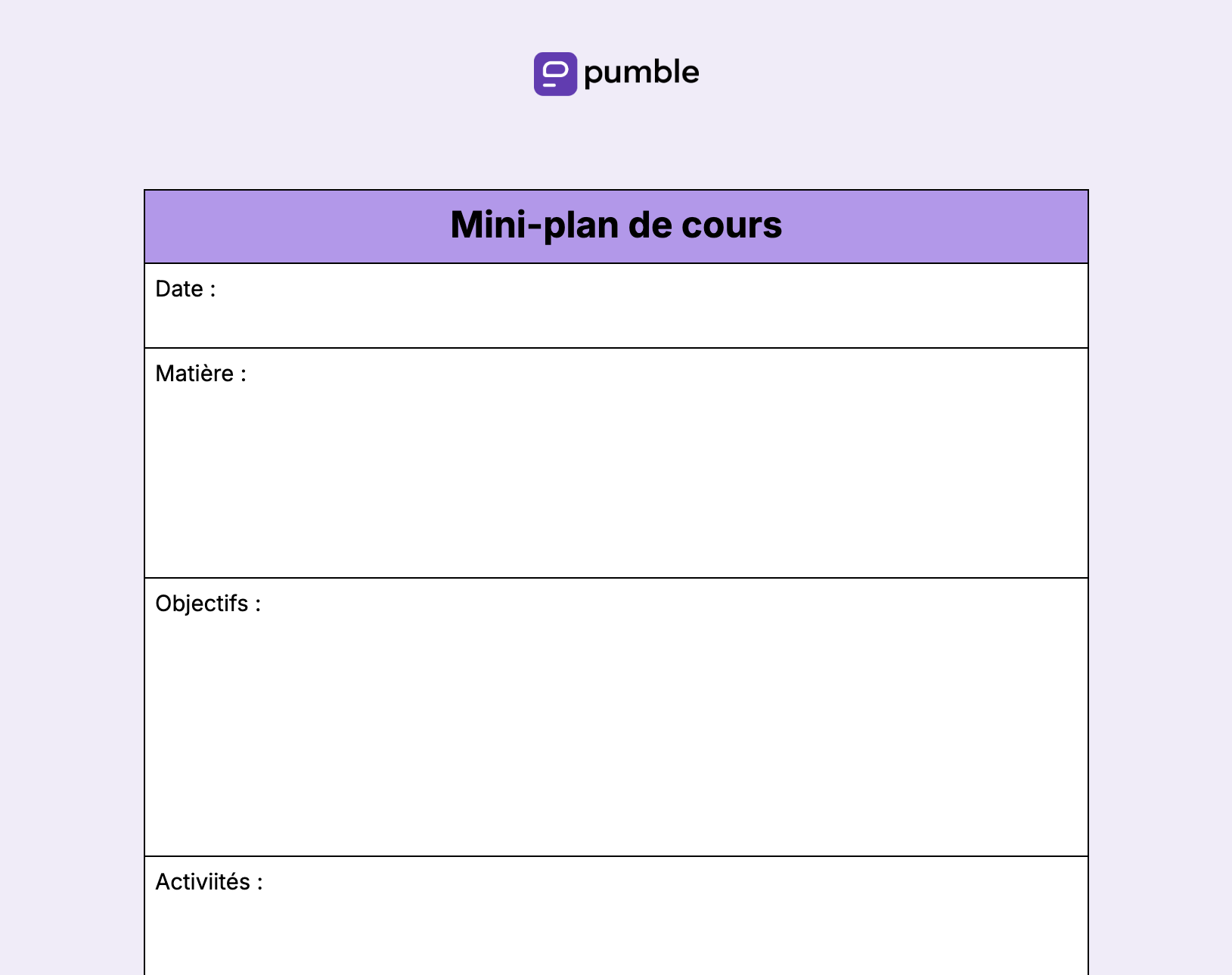
🔽 Télécharger le modèle de mini-plan de cours
🔽 Télécharger le modèle de mini-plan de cours imprimable
Simplifier la communication avec Pumble
Modèle n° 6 : Modèle de plan de cours pour l'enseignement à domicile
Le meilleur et aussi le pire de la planification des cours à domicile, c'est qu'elle offre une flexibilité illimitée.
C'est comme si vous étiez toujours à un jour de laisser vos élèves sécher l'examen de mathématiques pendant que vous partez pour votre sortie(scolaire) au parc le plus proche.
Cependant, un modèle de plan de cours solide devrait vous aider à respecter le programme habituel. Il se trouve que nous avons le modèle de plan de cours idéal pour vous aider à atteindre vos objectifs pédagogiques.
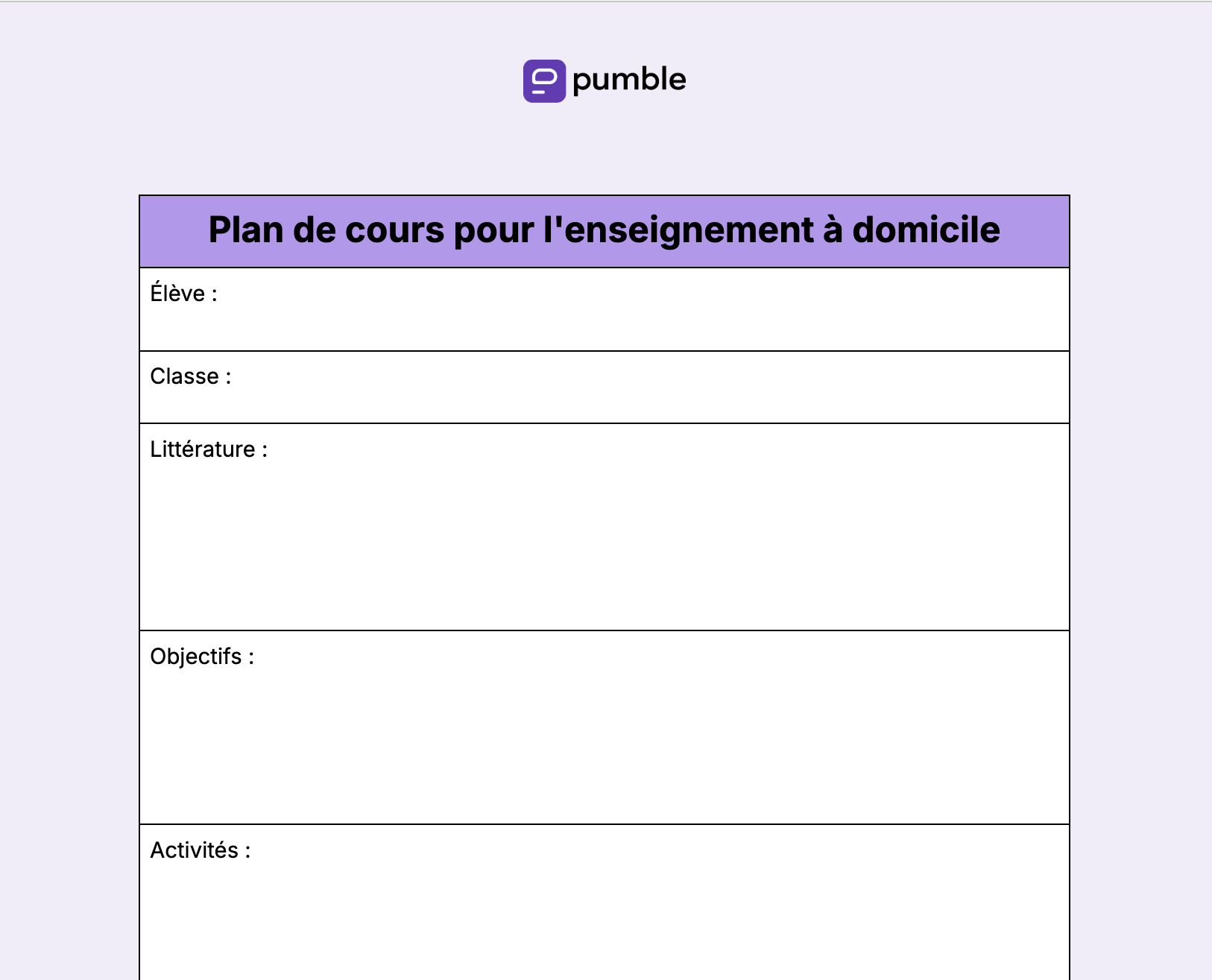
🔽 Télécharger le modèle de plan de cours pour l'enseignement à domicile
🔽 Télécharger le modèle de plan de cours pour l'enseignement à domicile imprimable
Create a homeschooling community on Pumble
Modèle n° 7 : Modèle de plan de cours créatif
Les cours créatifs sont un excellent moyen de développer l'esprit critique des élèves et de renforcer leur confiance en eux-mêmes grâce à des activités pratiques.
L'utilisation d'activités d'apprentissage interactives comme l'art, le théâtre, les sorties scolaires, les expériences et les conférences peut aider vos élèves à s'impliquer davantage dans le programme. Si vous avez besoin d'aide pour créer des plans de cours inspirants et stimulants pour vos élèves, essayez notre exemple de plan de cours créatif.

🔽 Télécharger le modèle de plan de cours créatif
🔽 Télécharger le modèle de plan de cours créatif imprimable
Créez votre classe numérique avec Pumble
Catégorie n° 2 : Modèles de plans de cours par période
Si vous cherchez de l'inspiration pour faire et organiser vos plans de cours par périodes, vous allez adorer.
Notre deuxième catégorie de modèles de plans de cours comprend 7 exemples de plans de cours que vous pouvez utiliser pour rédiger et organiser les activités d'apprentissage de vos élèves pour :
- Jour,
- Semaine,
- Période de deux semaines,
- Mois,
- Trimestre,
- Semestre, ou
- Année.
Quelle que soit la période choisie, les modèles de plans de cours suivants vous aideront à optimiser votre planification tout au long de l'année.
Modèle n° 1 : Modèle de plan de cours quotidien
En quête d'inspiration pour faire un plan de cours plus détaillé décrivant le but, les objectifs et les activités de vos cours au cours d'une journée ?
Notre modèle complet de plan de cours quotidien vous offre suffisamment d'espace pour noter toutes vos idées et observations sans oublier les points importants de chaque leçon.
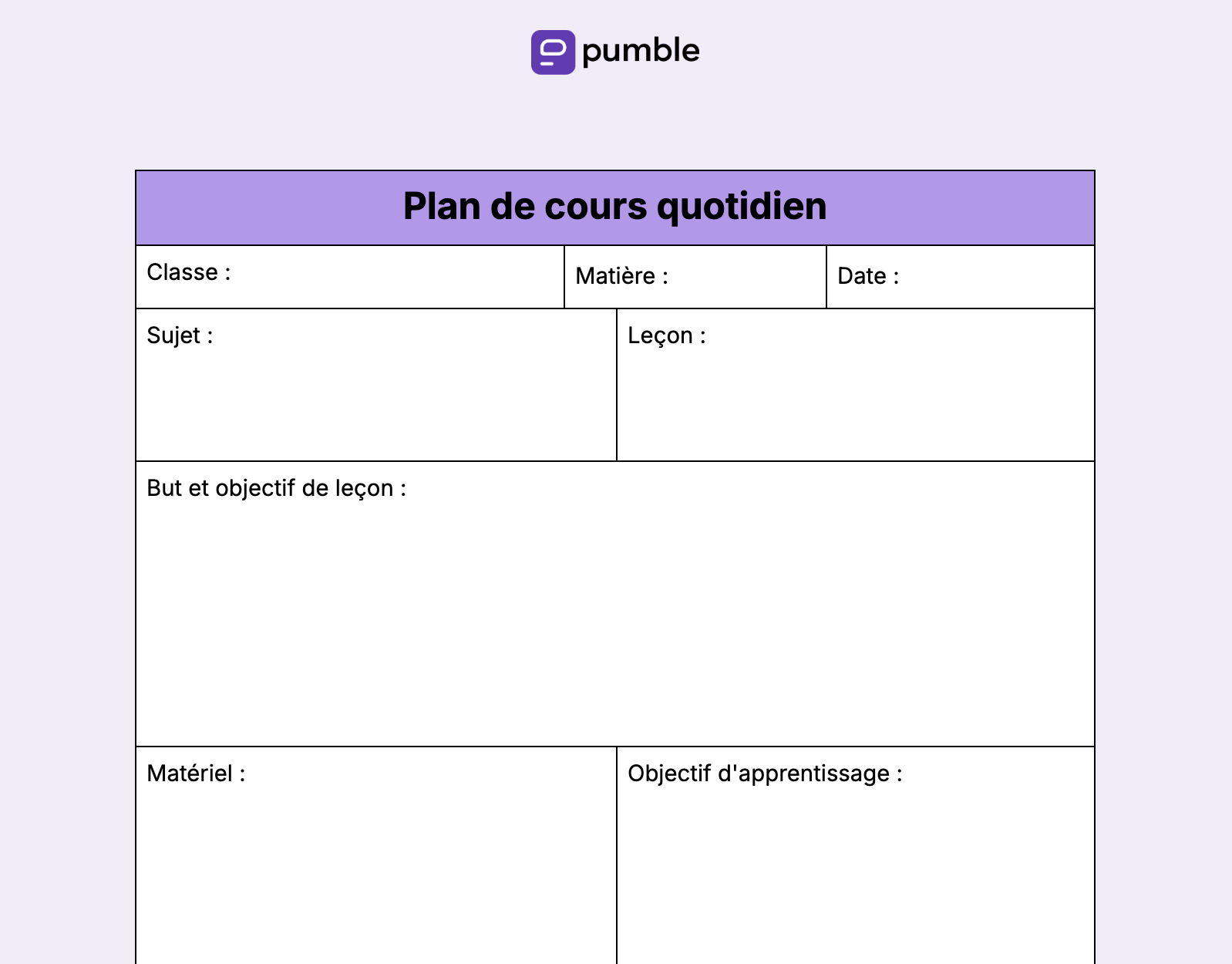
🔽 Télécharger le modèle de plan de cours quotidien
🔽 Télécharger le modèle de plan de cours quotidien imprimable
Partager les mises à jour avec le personnel sur Pumble
Modèle n° 2 : Modèle de plan de cours hebdomadaire
Si vous créez des plans de cours pour la semaine, vous pouvez utiliser 5 des plans de cours quotidiens que nous venons de partager ou intégrer une version abrégée de votre emploi du temps de cours sur un modèle de plan de cours hebdomadaire.
Dans tous les cas, vos cours seront parfaitement organisés. Voici un aperçu de notre modèle de plan de cours hebdomadaire pour vous aider à organiser vos prochains cours.
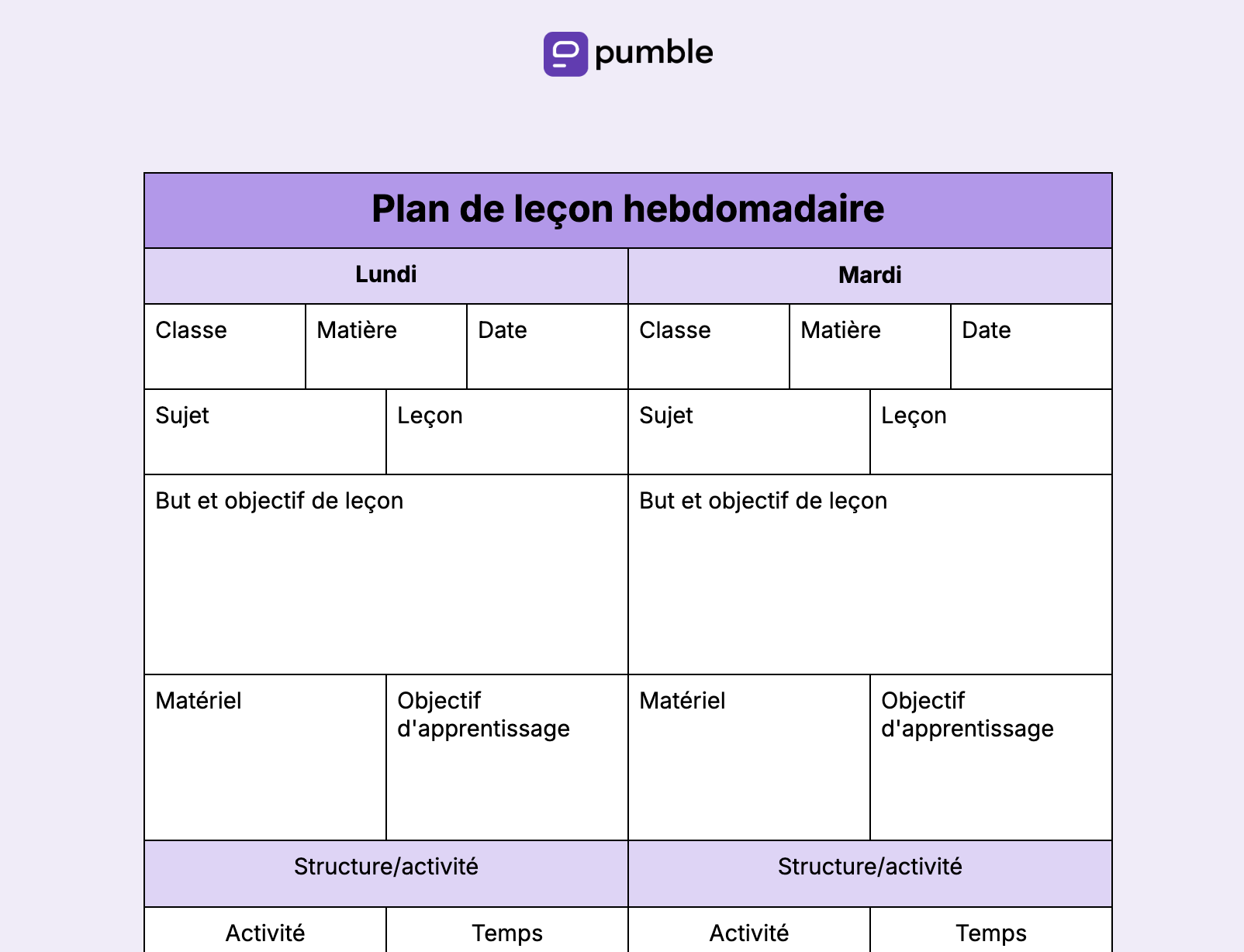
🔽 Télécharger le modèle de plan de cours hebdomadaire
🔽 Télécharger le modèle de plan de cours hebdomadaire imprimable
Modèle n° 3 : Modèle de plan de cours bihebdomadaire
Si vous préférez savoir ce que vous ferez quelques semaines à l'avance, vous pouvez toujours utiliser un modèle de plan de cours bimensuel.
Le format de plan de cours suivant est un peu plus large que ceux que nous venons de partager, ce qui vous permet d'y inclure des idées plus générales sur les activités d'apprentissage que vous souhaitez utiliser dans les semaines à venir.
Nous avons laissé ce modèle de plan de cours plus ouvert, afin que vous puissiez le personnaliser davantage en fonction de vos objectifs pédagogiques.
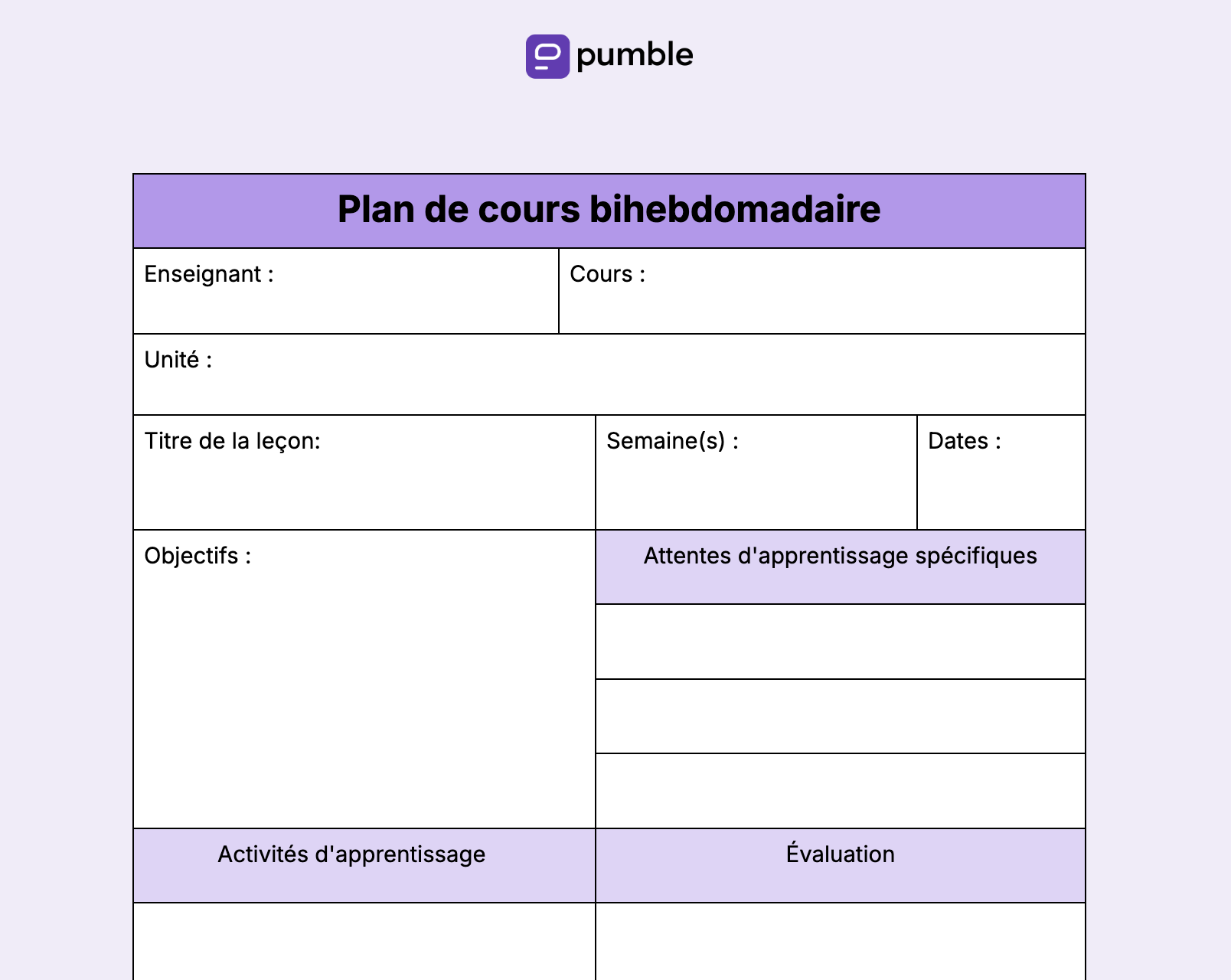
🔽 Télécharger le modèle de plan de cours bihebdomadaire
🔽 Télécharger le modèle de plan de cours bihebdomadaire imprimable
Restez en contact avec vos étudiants
Modèle n° 4 : Modèle de plan de cours mensuel
Les plans de cours mensuels offrent une perspective encore plus large que les plans de cours quotidiens et hebdomadaires.
Par exemple, votre plan de cours mensuel peut inclure vos idées concernant :
- Les sujets abordés,
- Le volume, les dates et les formats des évaluations de vos élèves,
- Les devoirs donnés, et
- Les types de ressources utilisées.
Pour conclure, nous avons même inclus une section pour les rappels importants. N'hésitez pas à adapter nos modèles de plans de cours à vos besoins.
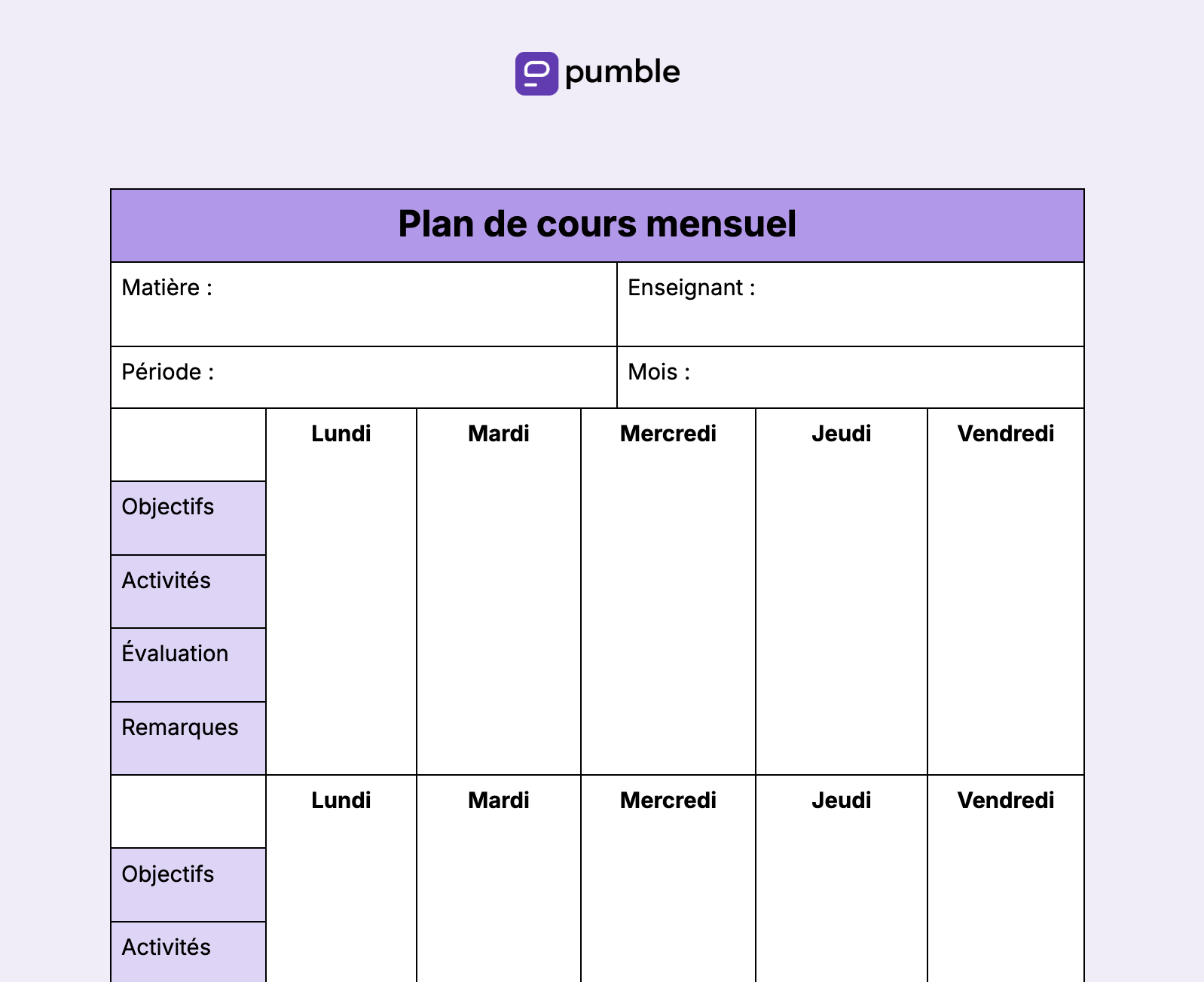
🔽 Télécharger le modèle de plan de cours mensuel
🔽 Télécharger le modèle de plan de cours mensuel imprimable
Modèle n° 5 : Modèle de plan de cours trimestriel
Un plan de cours trimestriel vous permet de définir clairement vos priorités en organisant tout ce que vos élèves feront au cours des prochains mois.
En plus de définir clairement vos principaux objectifs pédagogiques et d'apprentissage, notre modèle de plan de cours trimestriel vous permet également d'y ajouter tout ce dont vous aurez besoin pour l'avenir.
Une fois votre plan de cours des prochains mois créé, vous pouvez également l'utiliser pour compléter vos modèles de plans de cours mensuels et hebdomadaires.
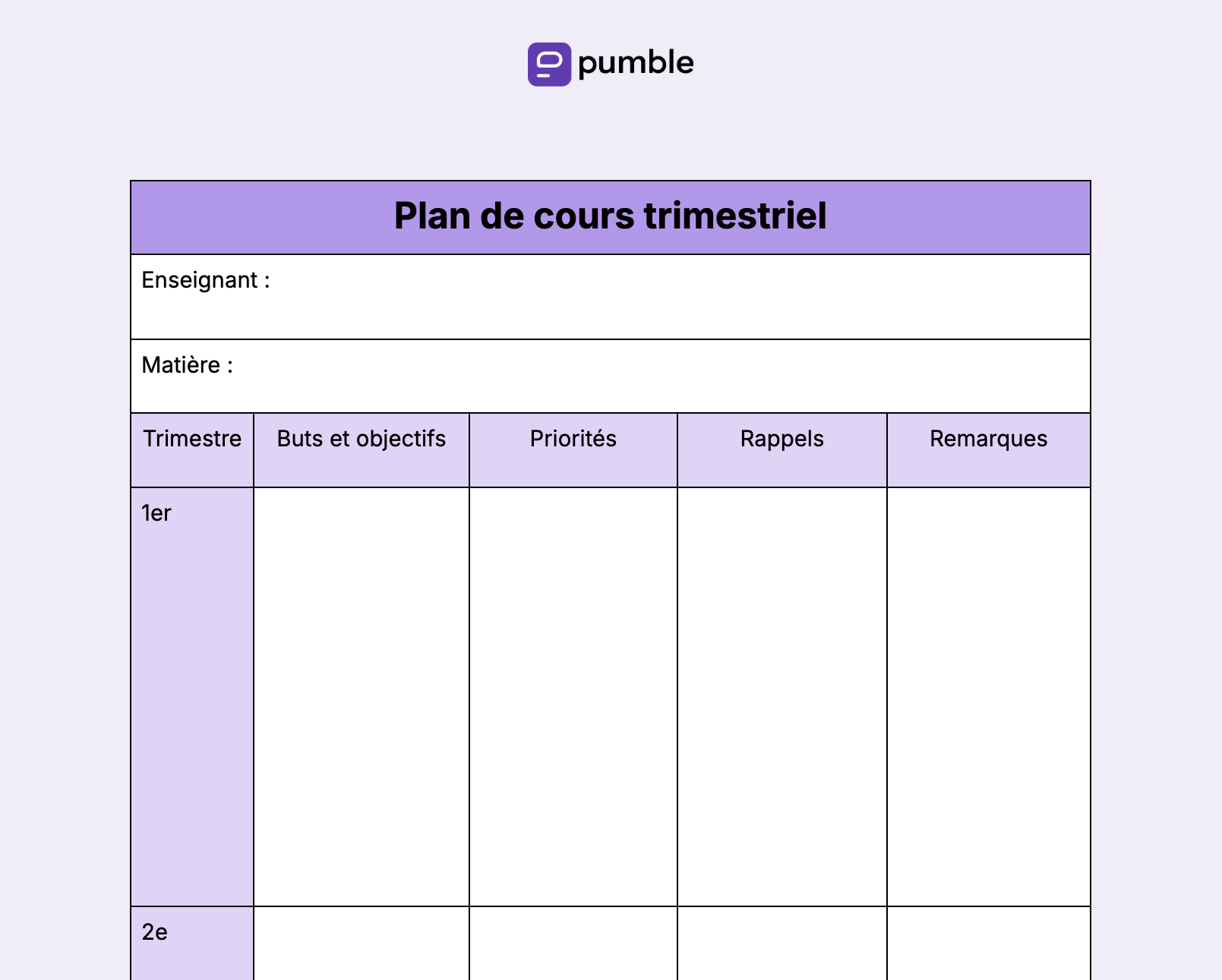
🔽 Télécharger le modèle de plan de cours trimestriel
🔽 Télécharger le modèle de plan de cours trimestriel imprimable
Modèle n° 6 : Modèle de plan de cours semestriel
Si notre modèle de plan de cours trimestriel vous permet d'avoir une vue d'ensemble rapide de toute l'année scolaire, un plan de cours semestriel est idéal pour une analyse semestrielle.
Il vous permet notamment de prendre en compte les éléments clés de votre plan de cours, tels que :
- Objectifs de cours,
- Plan de cours,
- Objectifs de performance,
- Règlement de la classe,
- Politique de notation, et
- Ressources et matériel.
Si vous recherchez un modèle de plan de cours à la fois complet et détaillé, essayez notre modèle complet de plan de cours semestriel.
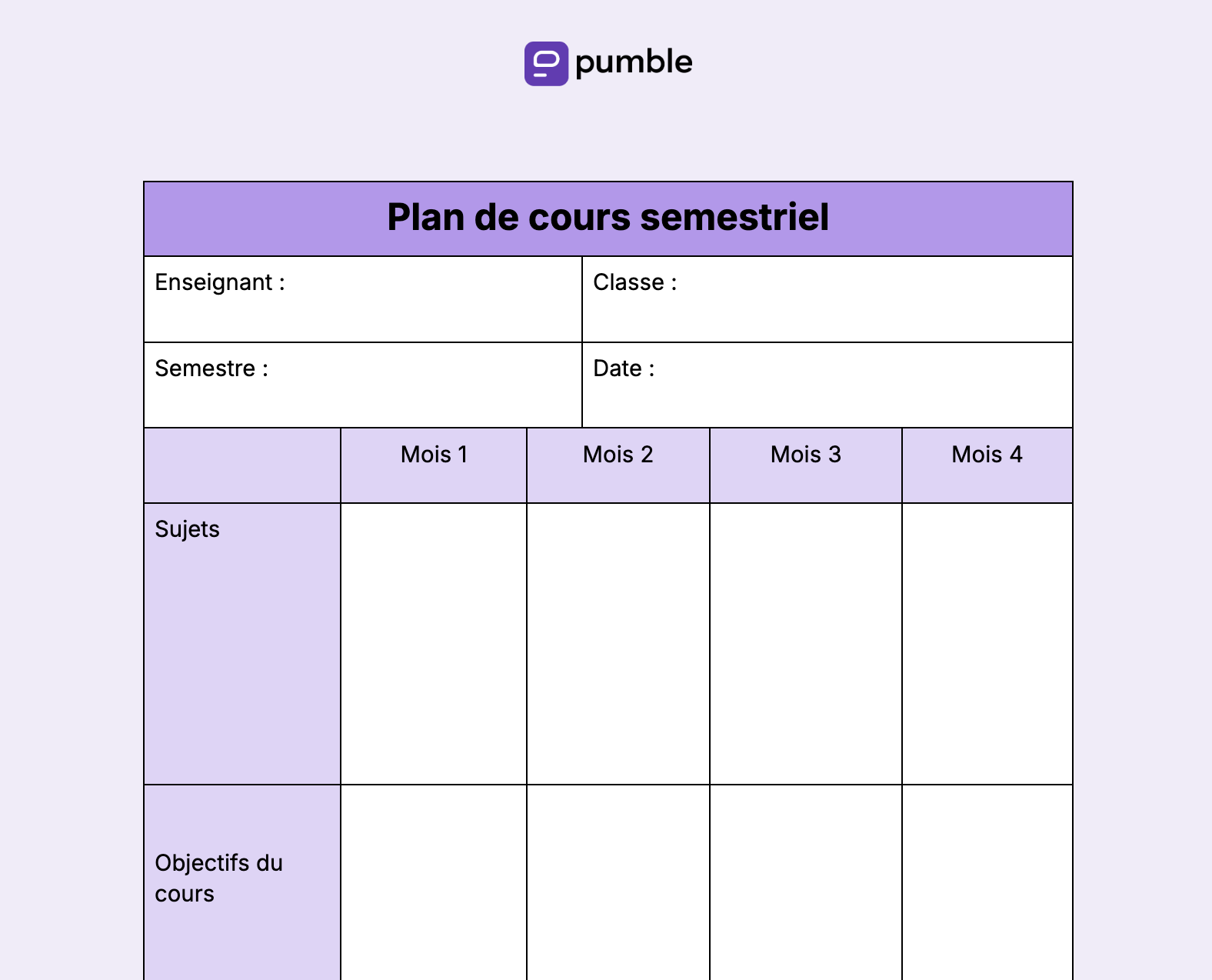
🔽 Télécharger le modèle de plan de cours semestriel
🔽 Télécharger le modèle de plan de cours semestriel imprimable
Modèle n° 7 : Modèle de plan de cours annuel
Comme son nom l'indique, un plan de cours annuel nécessite une planification pour une année scolaire complète, incluant (sans s'y limiter) des catégories telles que :
- Thèmes ou sujets de discussion,
- Objectifs d'apprentissage et
- Résultats spécifiques.
Voici un exemple de plan de cours annuel que vous pouvez personnaliser à votre guise.
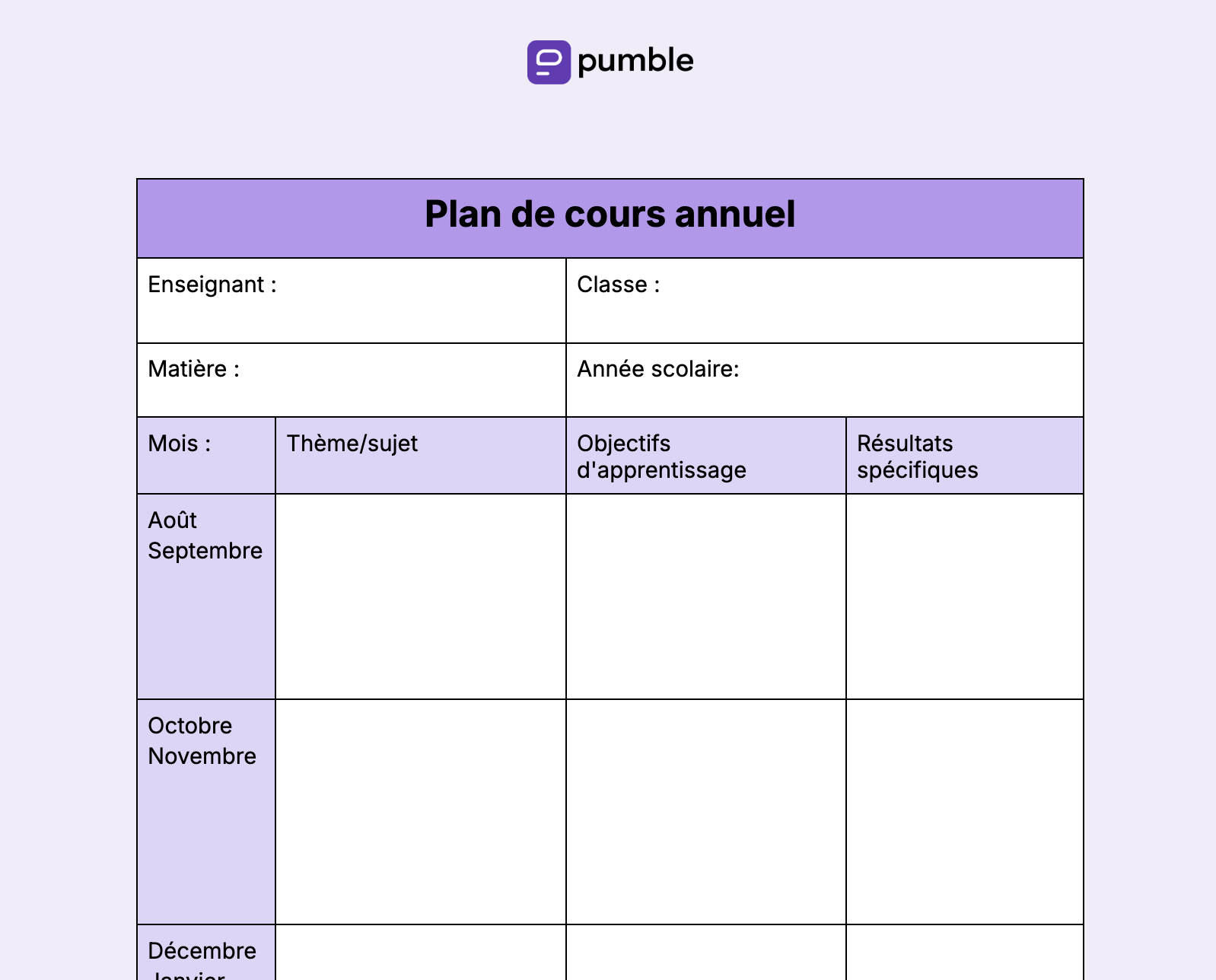
🔽 Télécharger le modèle de plan de cours annuel
🔽 Télécharger le modèle de plan de cours annuel imprimable
Restez en contact avec vos collègues avec Pumble
Catégorie n° 3 : Modèles de plans de cours pour l'école maternelle (petite section)
La planification des cours pour l'école maternelle comporte beaucoup de défis et de responsabilités. Vous devez notamment :
- Vous assurer un ensemble d'activités d'apprentissage adaptées au développement de l'enfant,
- Planifier assez de temps de jeu, et
- Être réflexif et flexible pour créer un espace pour les objectifs, les capacités et les intérêts de chacun.
Pour vous aider à démarrer la planification de vos cours pour l'école maternelle, nous avons préparé deux exemples de plans de cours qui pourraient s'adapter à votre situation.
Modèle n° 1 : Plan de cours hebdomadaire pour l'école maternelle
Notre premier modèle de cours pour la maternelle propose un plan de cours hebdomadaire simple avec le thème général de la semaine, divisé en sections d'activités.
Inspirez-vous de notre modèle de plan de cours modifiable pour la maternelle ou adaptez-le à vos idées et à vos sujets.
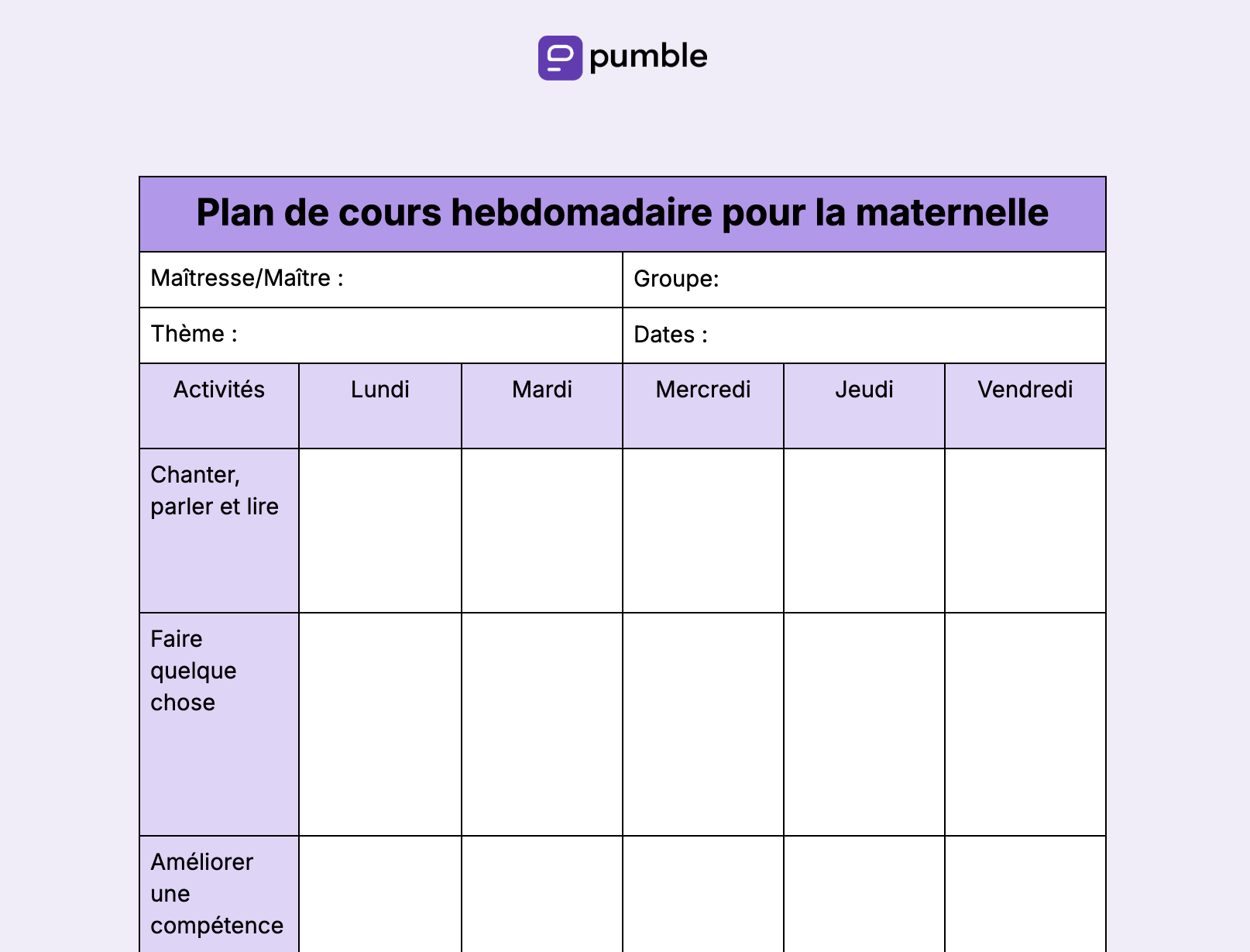
🔽 Télécharger le plan de cours hebdomadaire pour l'école maternelle
🔽 Télécharger le plan de cours hebdomadaire pour l'école maternelle imprimable
Modèle n° 2 : Plan de cours vierge pour l'école maternelle
Si vous cherchez un modèle de plan de cours plus libre et personnalisable, celui-ci est fait pour vous.
N'hésitez pas à utiliser notre exemple de plan de cours vierge pour la planification de vos cours en maternelle, ou utilisez-le simplement comme exemple pour créer votre propre modèle.
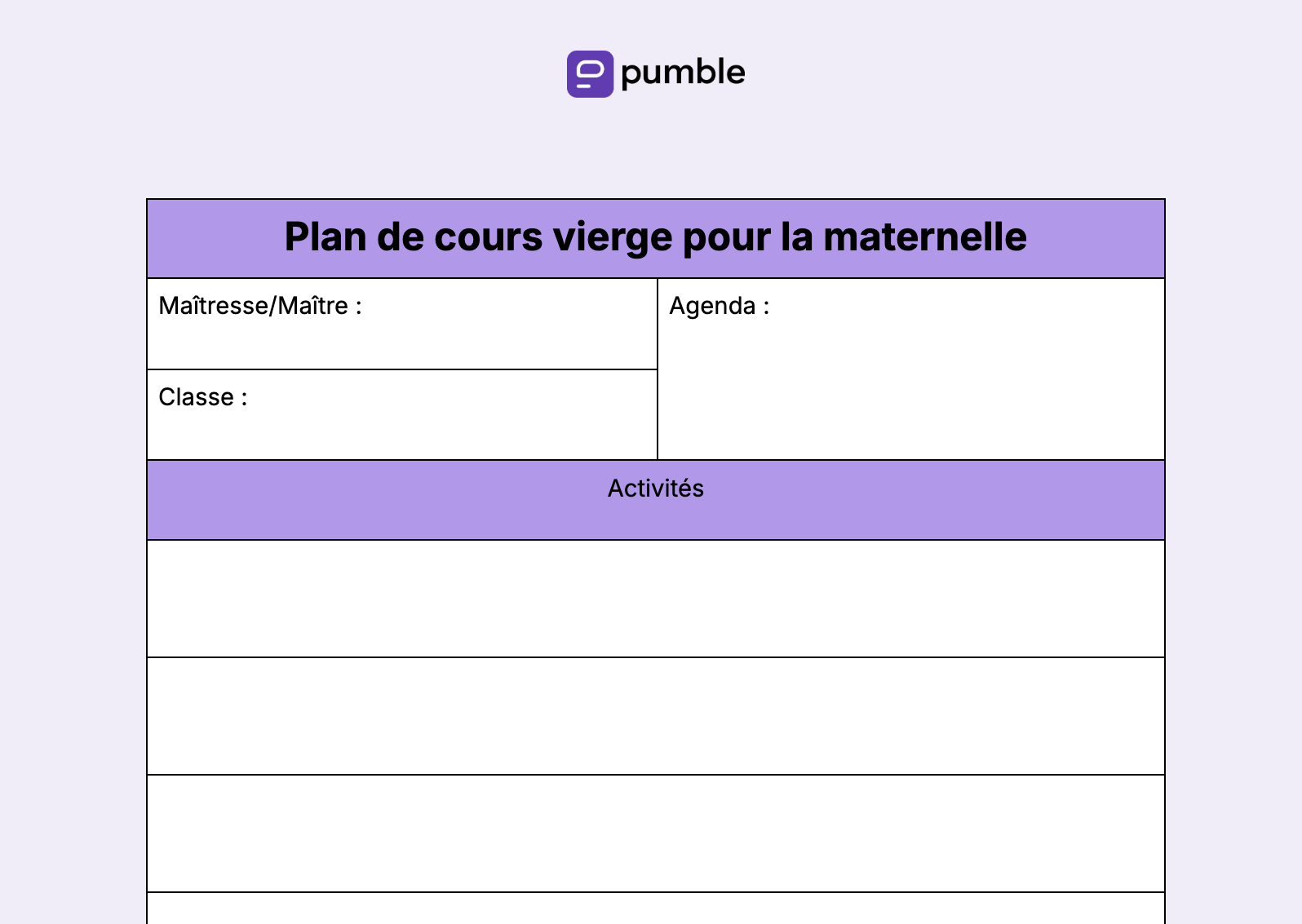
🔽 Télécharger le plan de cours vierge pour l'école maternelle
🔽 Télécharger le plan de cours vierge pour l'école maternelle imprimable
Tenez les parents de vos enfants de maternelle informés sur Pumble
Catégorie n° 4 : Modèles de plans de cours pour la maternelle (grande section)
Planifier des cours pour la maternelle représente une responsabilité particulière qu'aucun enseignant ne veut prendre pour acquis. Vous savez pertinemment qu'il s'agit de la première expérience de vos élèves dans l'enseignement formel ; vous souhaitez donc les aider à bien démarrer.
Bien que très créative et enrichissante, planifier efficacement des cours pour la maternelle peut aussi s'avérer un véritable défi. C'est pourquoi nous avons préparé quelques modèles de plans de cours pour la maternelle pour vous aider à démarrer.
Modèle n° 1 : Plan de cours hebdomadaire pour la grande section maternelle
Si vous cherchez un modèle simple de plan de cours hebdomadaire pour la maternelle, vous pouvez utiliser le modèle de plan de cours suivant.
Vous pouvez également l'utiliser comme point de départ pour créer votre propre modèle de plan de cours hebdomadaire pour la maternelle.
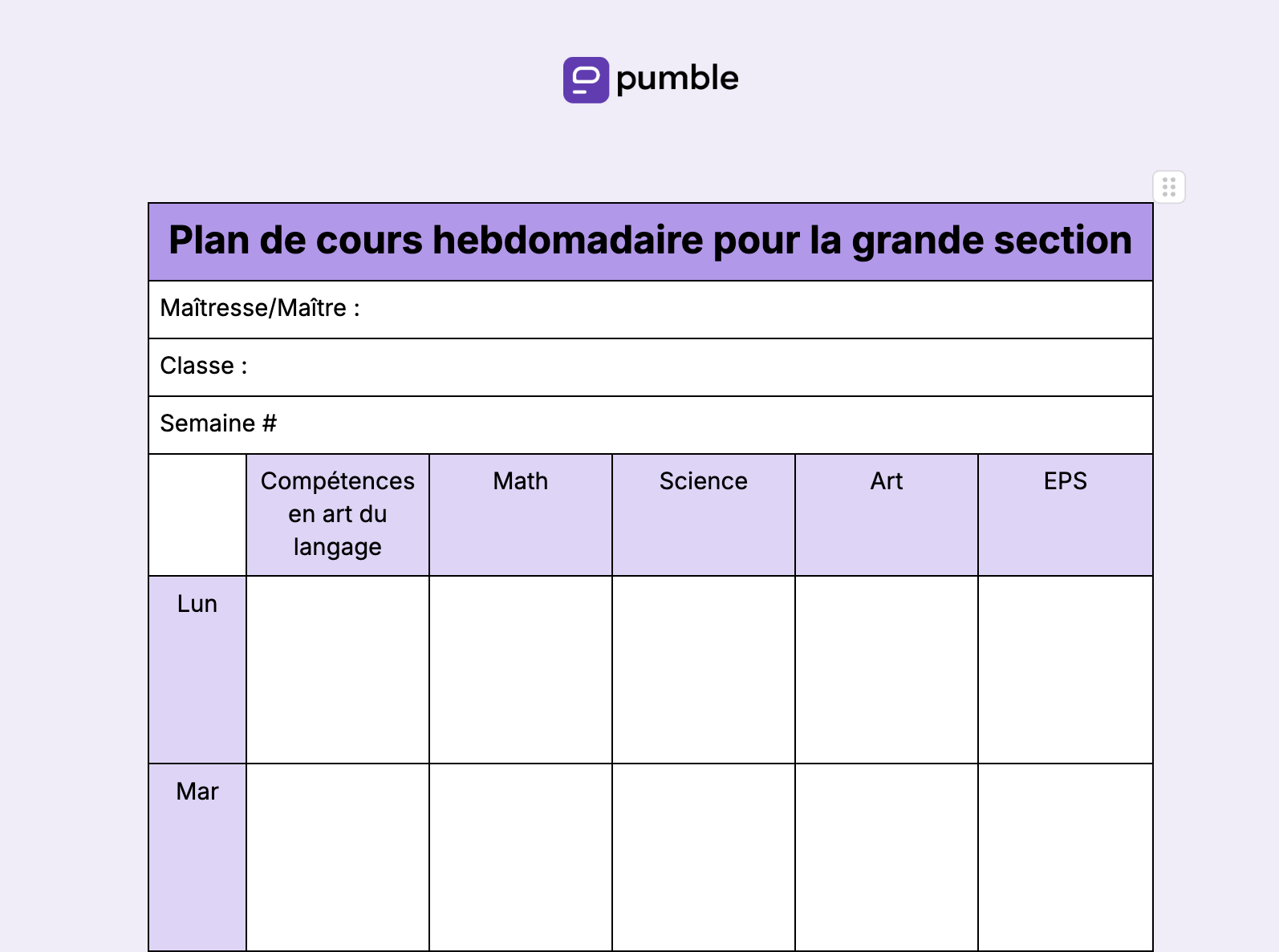
🔽 Télécharger le modèle de plan de cours hebdomadaire pour la grande section
🔽 Télécharger le modèle de plan de cours hebdomadaire pour la grande section imprimable
Modèle n° 2 : Plan de cours vierge pour la grande section maternelle
Si vous pensez qu'un format de plan de cours plus flexible serait plus utile, vous pouvez essayer ce modèle simple.
Notre modèle de plan de cours vierge pour les enseignants spécialisés en éducation préscolaire vous permettra d'organiser votre classe par thème, sans perdre de vue les objectifs d'apprentissage de vos élèves.
De plus, vous disposerez de suffisamment d'espace pour noter vos idées d'activités d'apprentissage et vos travaux personnels.

🔽 Télécharger le modèle de plan de cours vierge pour la grande section
🔽 Télécharger le modèle de plan de cours vierge pour la grande section imprimable
S'accorder parfaitement avec tout le monde sur Pumble
Catégorie n° 5 : Modèles de plans de cours pour l'école primaire
Une planification de cours efficace est indispensable pour les enseignants du primaire et du primaire, qui doivent faire en sorte que les enfants de maternelle deviennent de véritables élèves.
Les programmes scolaires du primaire ayant tendance à suivre un calendrier plus strict, notre format de plan de cours pour les enseignants du primaire sera naturellement plus structuré.
Comme pour les deux catégories précédentes, nous avons élaboré deux exemples de plans de cours qui devraient être utiles aux enseignants du primaire.
Modèle n° 1 : Modèle de plan de cours hebdomadaire pour l'école primaire
Si vous cherchez une version condensée d'un plan de cours vierge, vous pouvez utiliser notre modèle de plan de cours hebdomadaire pour l'école primaire. Il présente les bases de la planification des cours pour l'école primaire, ainsi qu'une structure complète.
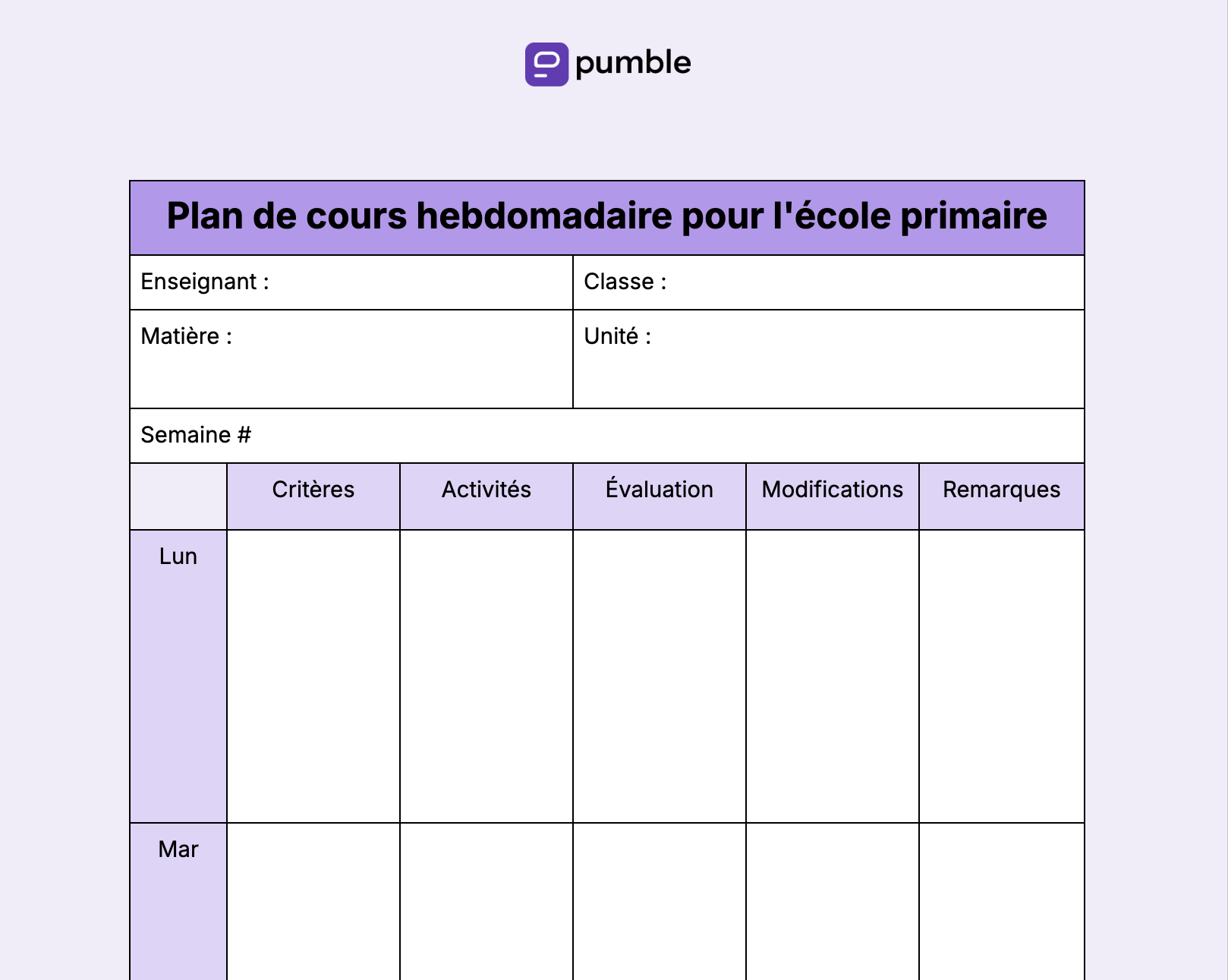
🔽 Télécharger le modèle de plan de cours hebdomadaire pour l'école primaire
🔽 Télécharger le modèle de plan de cours hebdomadaire pour l'école primaire imprimable
Modèle n° 2 : Modèle de plan de cours vierge pour l'école primaire
Si vous recherchez un modèle de plan de cours ultra-flexible, offrant suffisamment d'espace et d'options pour structurer les éléments clés de votre plan de cours, ce modèle est fait pour vous.
Comme toujours, vous pouvez vous en inspirer ou le remplir et l'imprimer en entier s'il correspond à vos attentes.
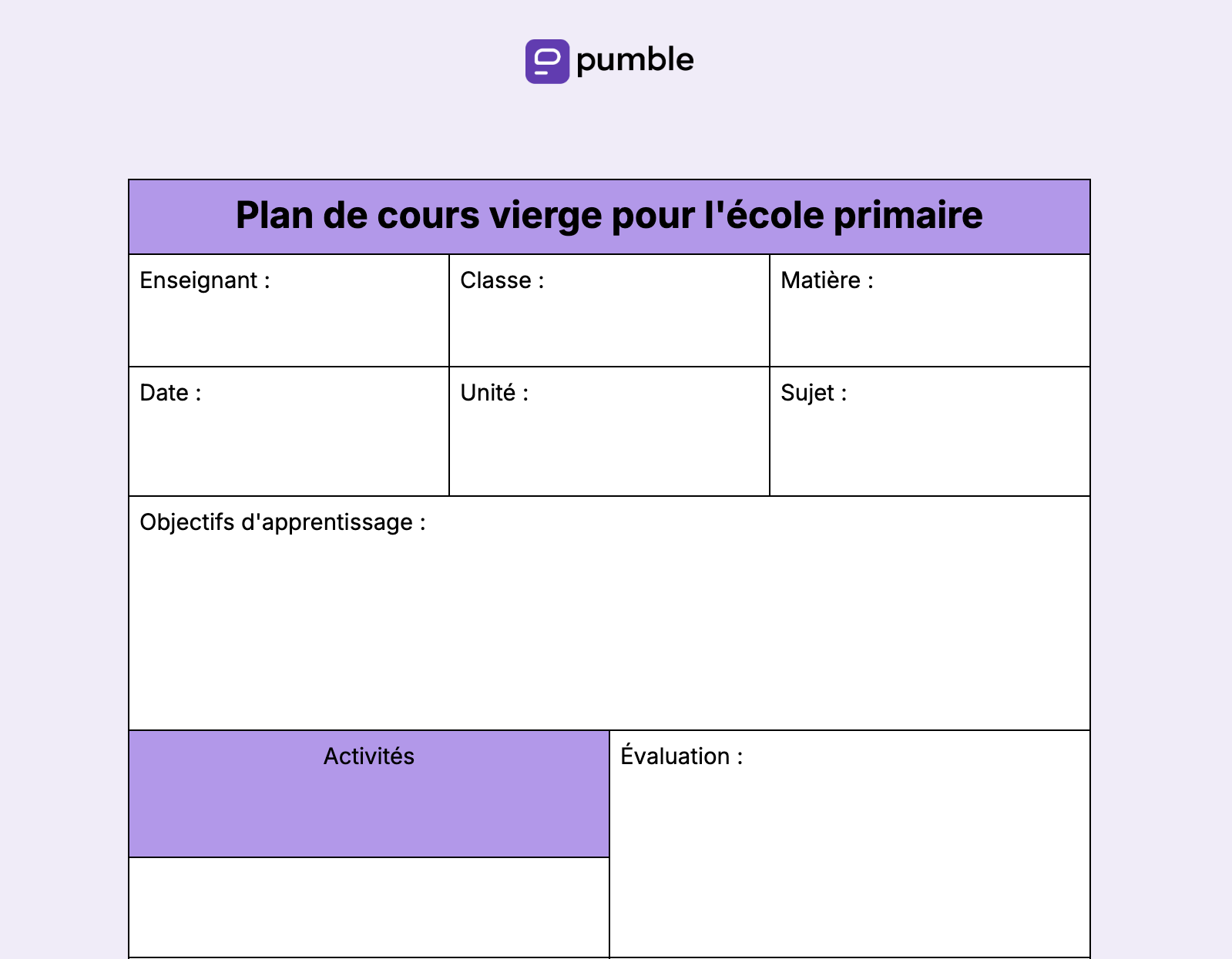
🔽 Télécharger le modèle de plan de cours vierge pour l'école primaire
🔽 Télécharger le modèle de plan de cours vierge pour l'école primaire imprimable
Catégorie n° 6 : Modèles de plan de cours pour collège
Enseigner aux collégiens peut s'avérer complexe. À cet âge, les enfants ont tendance à être réticents à l'apprentissage, il est donc essentiel d'encourager l'engagement en classe pour une planification efficace des cours.
Dans cette optique, nous avons élaboré deux exemples de plans de cours pour structurer votre programme scolaire.
Modèle n° 1 : Modèle de plan de cours pour un projet créatif au collège
Comme l'engagement en classe a tendance à diminuer à l'adolescence, les enseignants de collège doivent s'efforcer de motiver leurs élèves à atteindre leurs objectifs d'apprentissage.
Pour y parvenir, il est essentiel de leur offrir de nombreuses occasions d'expression personnelle, essentielle au développement et à l'apprentissage des collégiens.
Créer des plans de cours intégrant davantage d'activités d'apprentissage créatives peut donc être la solution idéale pour inspirer vos élèves. Si vous hésitez sur la méthode, consultez notre modèle de plan de cours pour un projet créatif destiné aux enseignants de collège ci-dessous.
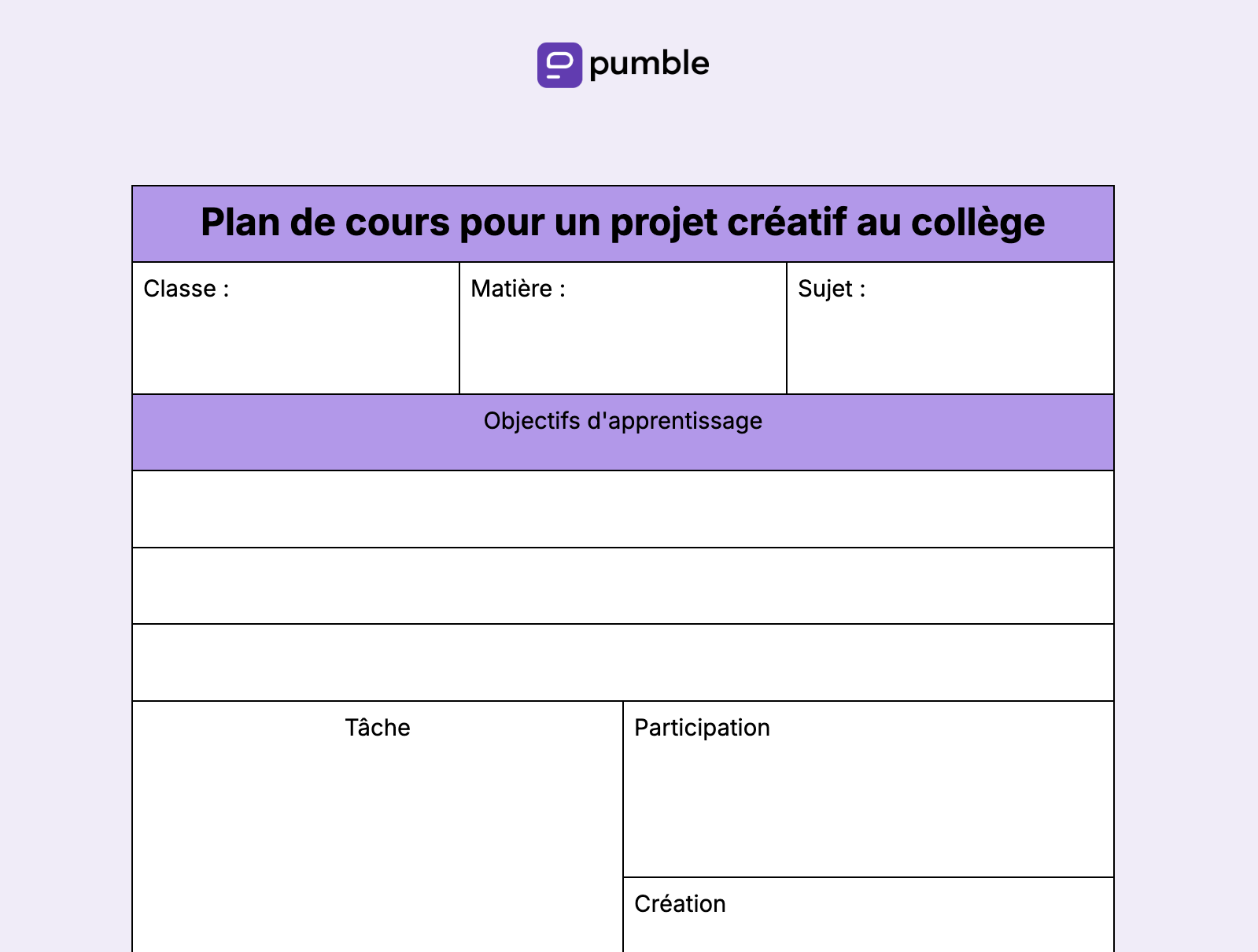
🔽 Télécharger le modèle de plan de cours pour un projet créatif au collège
🔽 Télécharger le modèle de plan de cours pour un projet créatif au collège imprimable
Modèle n° 2 : Modèle de plan de cours hebdomadaire pour le collège
Si vous recherchez un modèle de plan de cours plus standard pour le collège afin d'organiser la semaine à venir, ce format est idéal.
L'exemple de plan de cours ci-dessous présente un modèle de plan de cours hebdomadaire standard pour les enseignants du collège. Il présente tous les éléments de base d'un plan de cours, ainsi qu'une section de réflexion supplémentaire, destinée à encourager les retours et l'introspection des élèves.
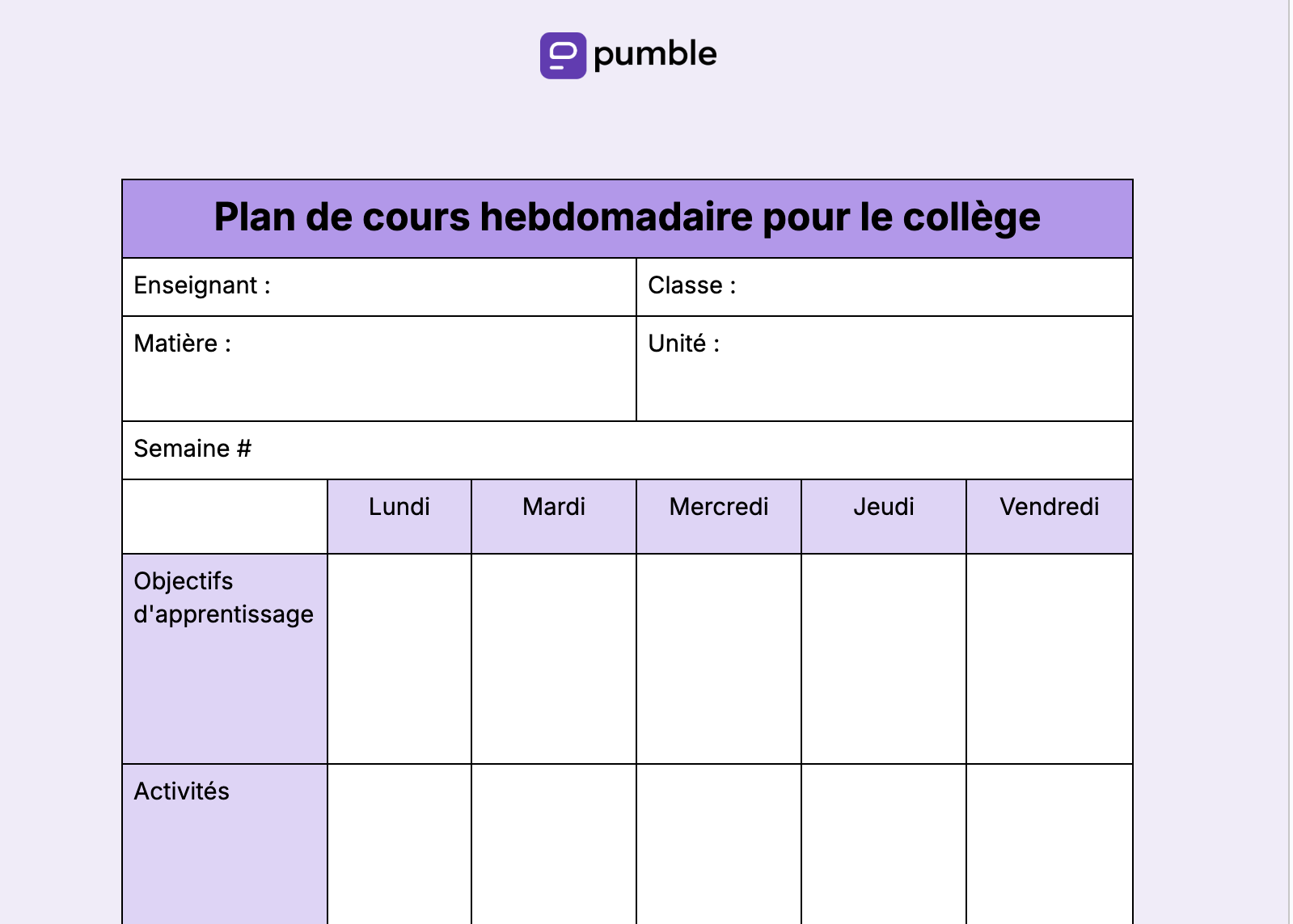
🔽 Télécharger le modèle de plan de cours hebdomadaire pour le collège
🔽 Télécharger le modèle de plan de cours hebdomadaire pour le collège imprimable
Communiquez avec les parents de vos étudiants via Pumble
Catégorie n° 7 : Modèles de plans de cours pour le lycée
Si vous recherchez un excellent modèle de plan de cours pour le lycée, vous devrez en trouver un qui laisse suffisamment de place pour les activités d'apprentissage individuelles et en groupe.
Étant donné que les plans de cours pour le lycée ont tendance à se concentrer davantage sur ce type d'opportunités d'apprentissage pour les élèves, les enseignants peuvent jouer le rôle de facilitateurs entre les élèves ou les groupes.
Dans cette optique, nous avons préparé deux exemples de plans de cours qui privilégient des activités d'apprentissage plus diversifiées pour les élèves du secondaire.
Modèle n° 1 : Modèle de plan de cours pour une seule leçon au lycée
L'utilisation de modèles de plans de cours pour le secondaire qui se concentrent sur les objectifs d'apprentissage que vous souhaitez atteindre au cours d'une seule leçon est le meilleur moyen de vous assurer que vos élèves assimilent vraiment ce que vous essayez de leur enseigner.
Ce type de format de plan de cours unique vous permet d'être aussi détaillé que vous le souhaitez tout en vous offrant la flexibilité nécessaire pour répondre aux besoins éducatifs individuels de vos élèves.
Si vous n'avez jamais créé de plan de cours pour une leçon individuelle auparavant, ce modèle de plan de cours pour le secondaire peut vous montrer comment procéder.
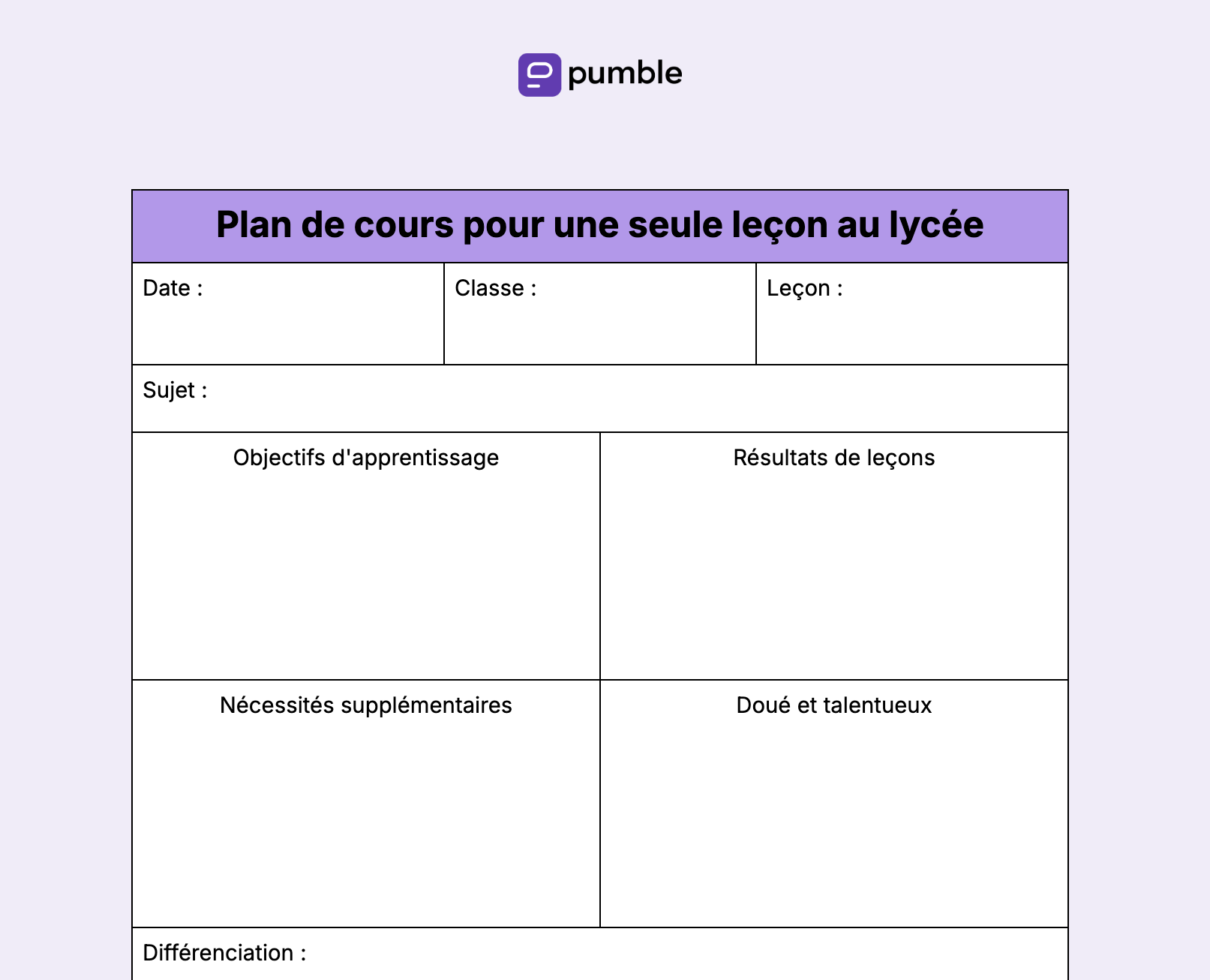
🔽 Télécharger le modèle de plan de cours pour une seule leçon au lycée
🔽 Télécharger le modèle de plan de cours pour une seule leçon au lycée imprimale
Contactez votre classe sur Pumble
Modèle n°2 : Modèle de plan de cours hebdomadaire pour le lycée
Tout comme les modèles de plans de cours hebdomadaires que nous avons créés pour les écoles maternelles, ce modèle de plan de cours hebdomadaire pour le lycée offre un aperçu utile de la semaine à venir.
Comme toujours, vous pouvez soit utiliser directement notre modèle de plan de cours hebdomadaire, soit créer le vôtre en vous basant sur les éléments clés que nous y avons inclus.
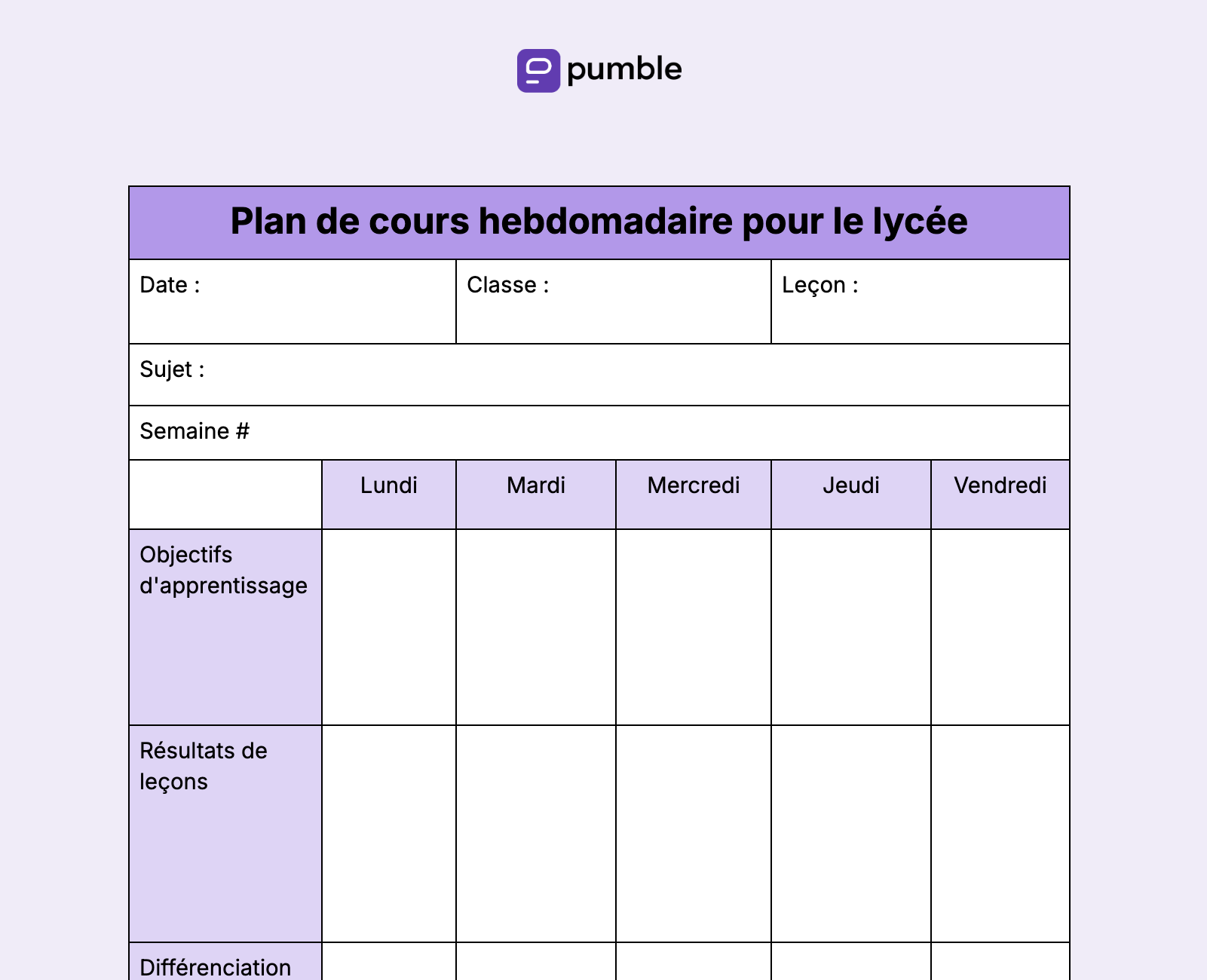
🔽 Télécharger le modèle de plan de cours hebdomadaire pour le lycée
🔽 Télécharger le modèle de plan de cours hebdomadaire pour le lycée imprimable
Catégorie n° 8 : Modèles de plan de cours pour l'université
De manière générale, les professeurs d'université ont souvent une approche plus structurée de la planification de leurs cours, car ils suivent le format de plan de cours fourni par leur établissement.
Cependant, si on vous a laissé carte blanche et demandé de créer vos propres plans de cours, les deux modèles suivants vous seront très utiles.
Modèle n° 1 : Modèle standard de plan de cours pour l'université
Un modèle standard de plan de cours pour l'université propose un aperçu des composantes clés d'une planification efficace. Il vous permet de renseigner :
- Vos objectifs pédagogiques,
- Les connaissances préalables requises,
- Les normes et indicateurs pertinents,
- Les procédures ou activités d'apprentissage,
- Ainsi que vos plans d'évaluation et de suivi.
Ceci étant dit, examinons notre exemple de plan de cours pour l'université.
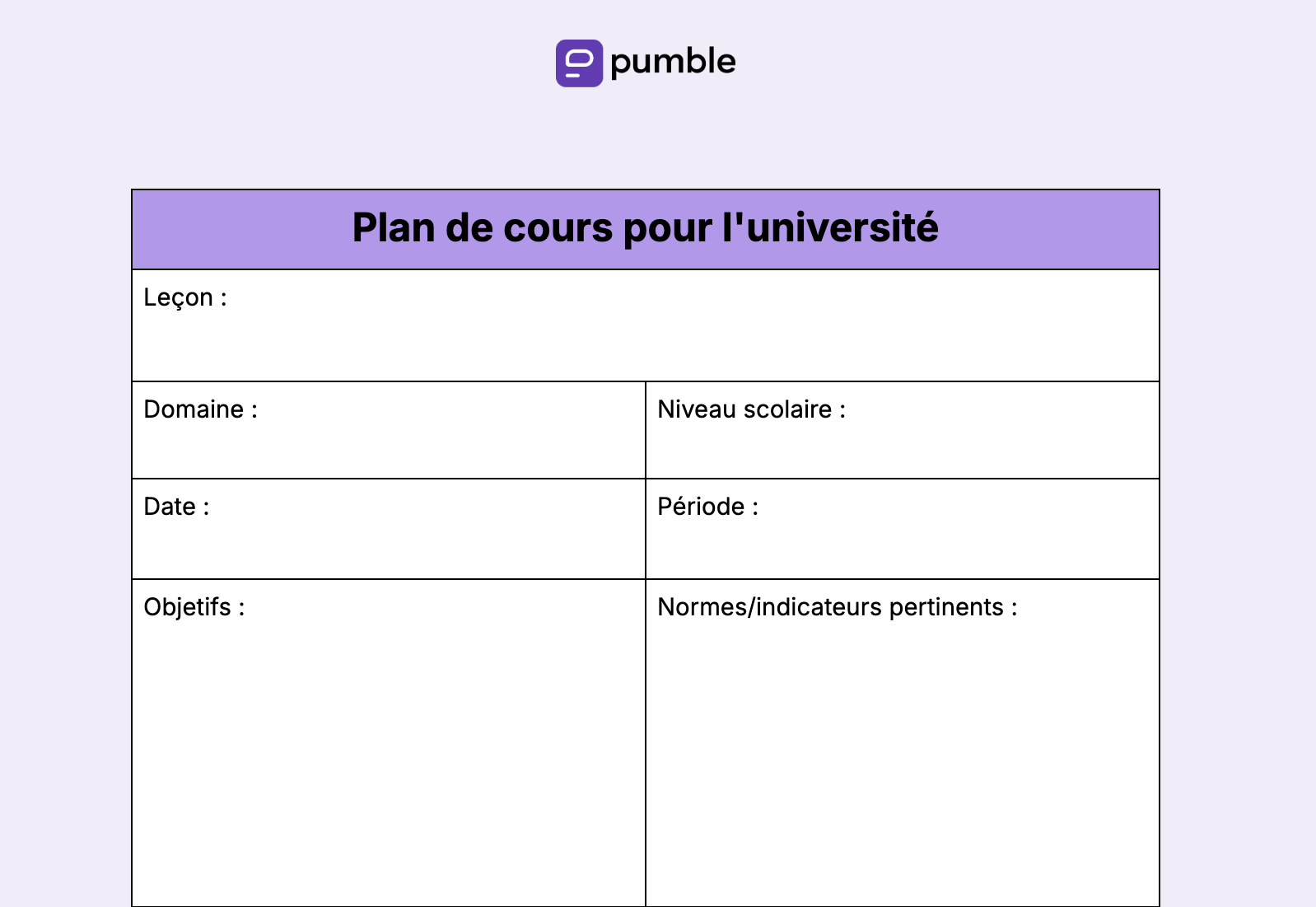
🔽 Télécharger le modèle standard de plan de cours pour l'université
🔽 Télécharger le modèle standard de plan de cours pour l'université imprimable
Partagez les mises à jours importantes des cours sur Pumble
Modèle n°2 : Modèle simple de plan de cours pour l'université
Alors que le modèle de plan de cours standard que nous avons partagé ci-dessus peut être utilisé pour détailler une seule leçon, ce modèle simple est idéal pour organiser plusieurs cours autour du même sujet.
Vous pouvez également utiliser ce format pour diviser une seule conférence en plusieurs parties, en indiquant la durée de chaque segment dans la dernière colonne du modèle.
Comme toujours, la manière dont vous utilisez notre exemple de plan de cours dépend entièrement de vous.
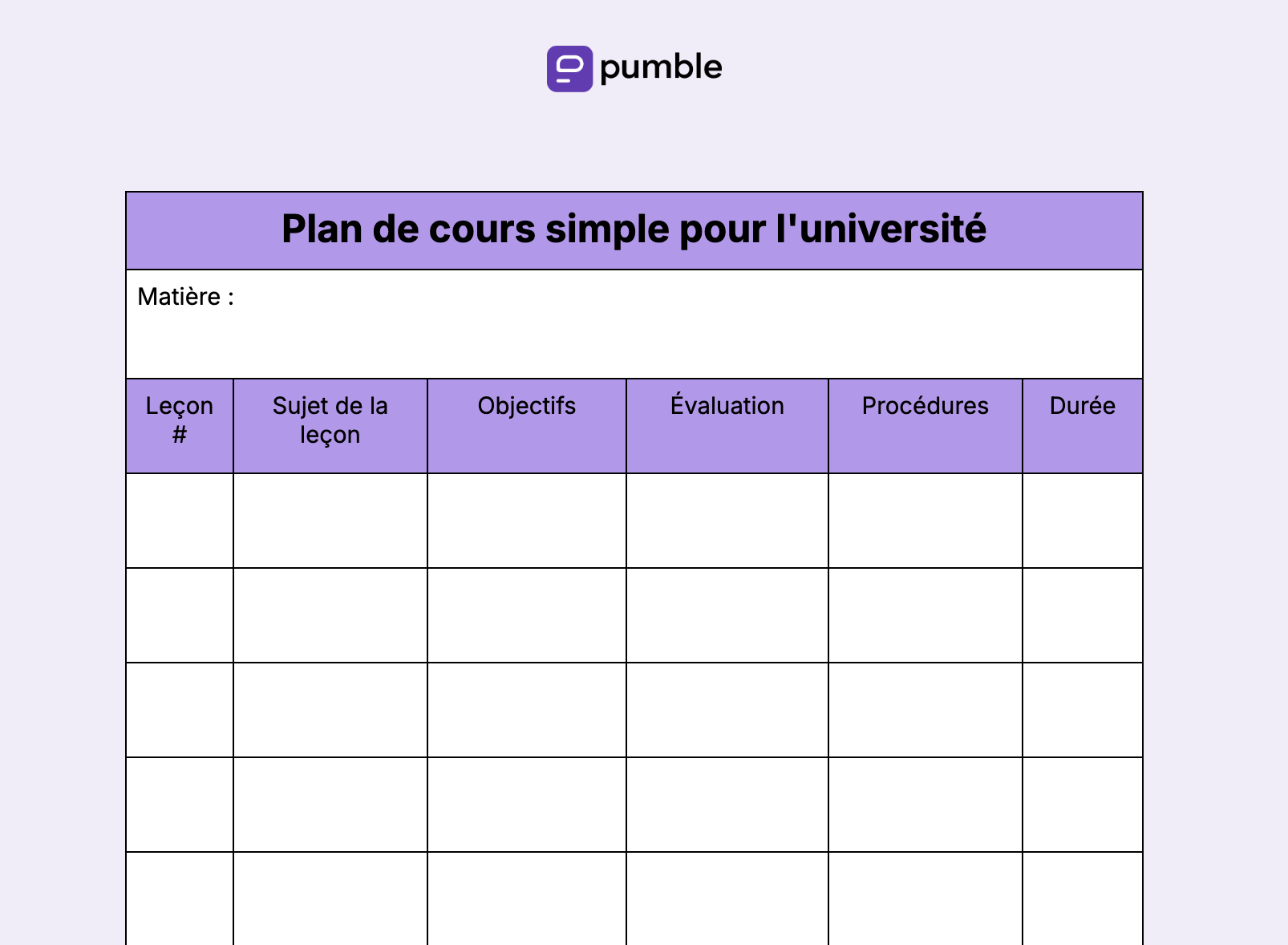
🔽 Télécharger le modèle simple de plan de cours pour l'université
🔽 Télécharger le modèle simple de plan de cours pour l'université imprimable
Catégorie n° 9 : Modèles de plan de cours par matière
Lorsque les enseignants élaborent des plans de cours pour des matières spécifiques, ils constatent que la structure reste généralement la même, à l'exception de certaines composantes clés propres à leur discipline.
Les variations et les spécificités se retrouvent principalement au niveau des :
- Méthodes d'enseignement,
- Types d'activités pédagogiques,
- Matériels, outils et ressources utilisés.
Pour mieux illustrer cela, nous avons préparé 10 modèles de plans de cours modifiables pour des matières précises. Vous pouvez les utiliser comme base et les adapter à votre convenance, ou bien les remplir directement et les imprimer s'ils correspondent parfaitement à vos besoins.
Modèle n°1 : Modèle de plan de cours de mathématiques
En tant que professeur de mathématiques, vous connaissez certainement le défi de traduire des problèmes complexes en concepts simples et accessibles à tous.
C'est pourquoi une planification de cours efficace est essentielle. Elle vous permet de réfléchir en amont à vos leçons et activités, de préparer de nombreux exemples pertinents, et d'anticiper les difficultés potentielles pour mieux y faire face.
Voici donc notre version d'un modèle de plan de cours simple pour structurer vos classes de mathématiques.
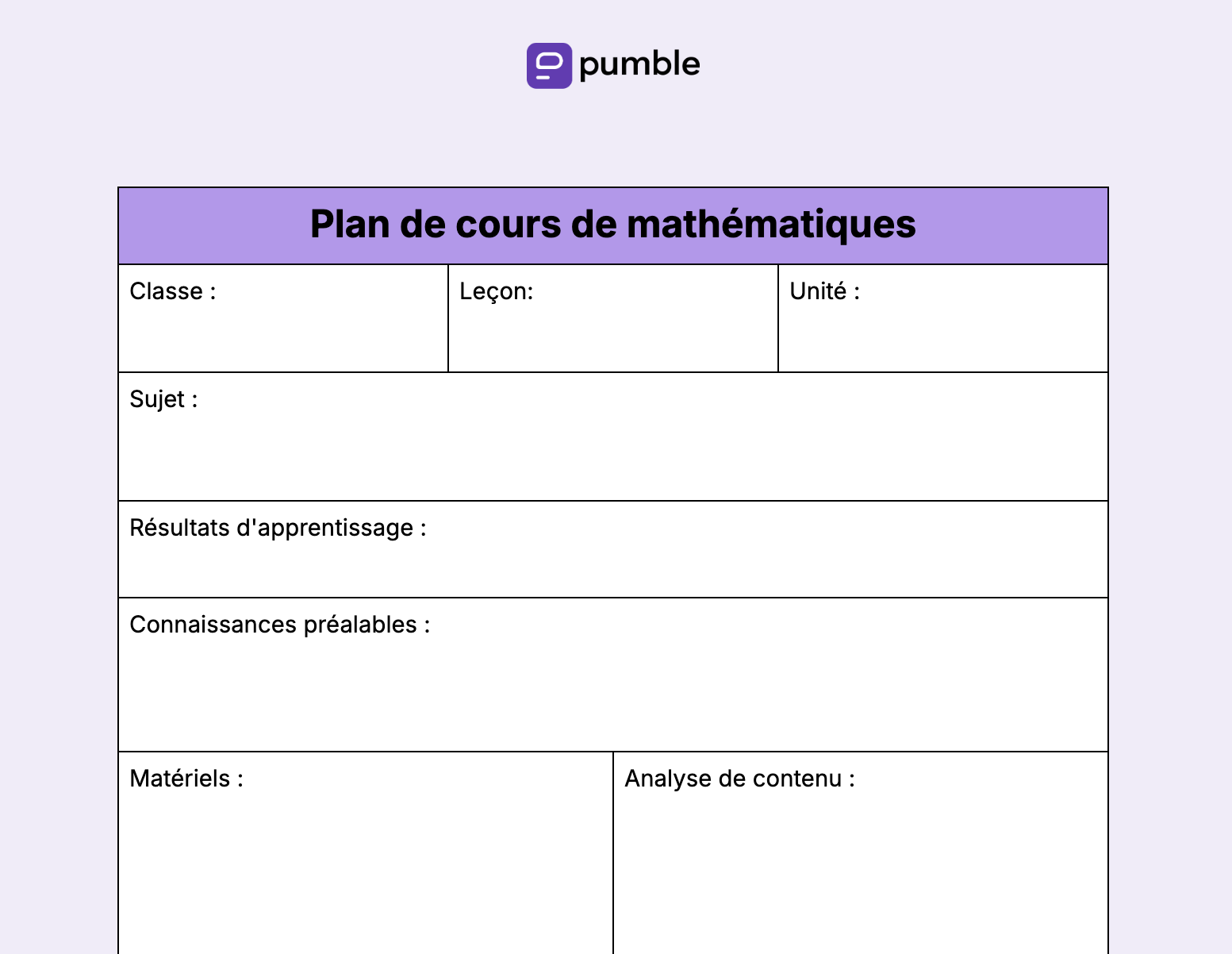
🔽 Télécharger le modèle de plan de cours de mathématiques
🔽 Télécharger le modèle de plan de cours de mathématiques imprimable
Créer une expérience d'apprentissage collaboratif avec Pumble
Modèle n° 2 : Modèle de plan de cours de sciences
Créer des plans de cours pour un cours de sciences peut être une activité créative, permettant d'intégrer toutes sortes de matériels spécifiques et d'activités d'apprentissage expérimentales.
Sortir des sentiers battus est le meilleur moyen d'aider vos élèves à appréhender des concepts scientifiques complexes grâce à des activités d'apprentissage pratiques. L'exemple de plan de cours ci-dessous illustre ce à quoi pourrait ressembler ce type de cours en pratique.
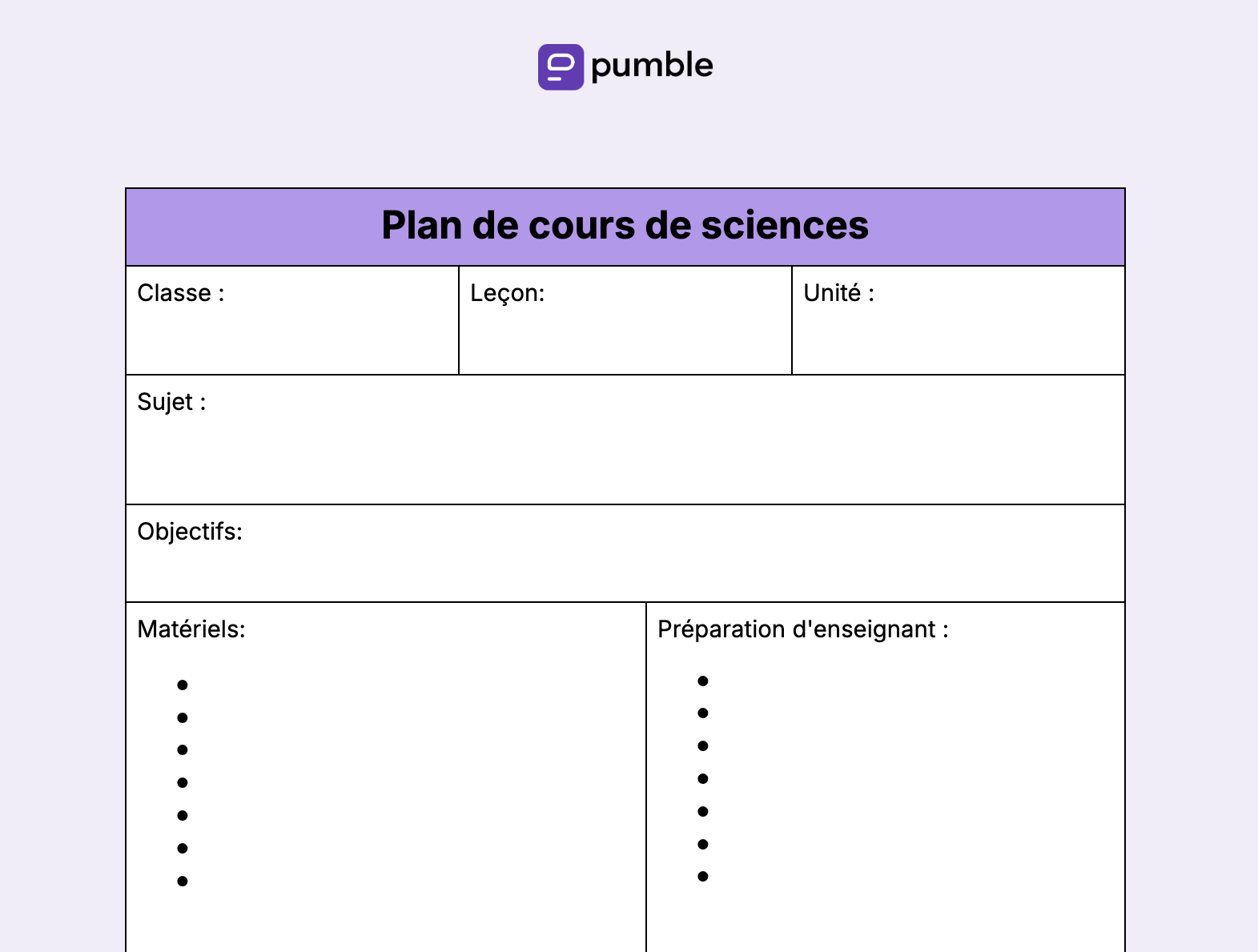
🔽 Télécharger le modèle de plan de cours de sciences
🔽 Télécharger le modèle de plan de cours de sciences imprimable
Partager des ressources avec la classe via Pumble
Modèle n° 3 : Modèle de plan de cours d'histoire
Contrairement aux sciences, qui proposent souvent des activités d'apprentissage stimulantes intégrées au programme, l'histoire exige un enseignant capable de présenter la matière de manière captivante.
Cependant, pour y parvenir, il ne suffit pas d'avoir du charisme : il faut aussi un plan de cours pertinent.
Heureusement, notre modèle de plan de cours d'histoire devrait faciliter la planification de cours d'histoire captivants.
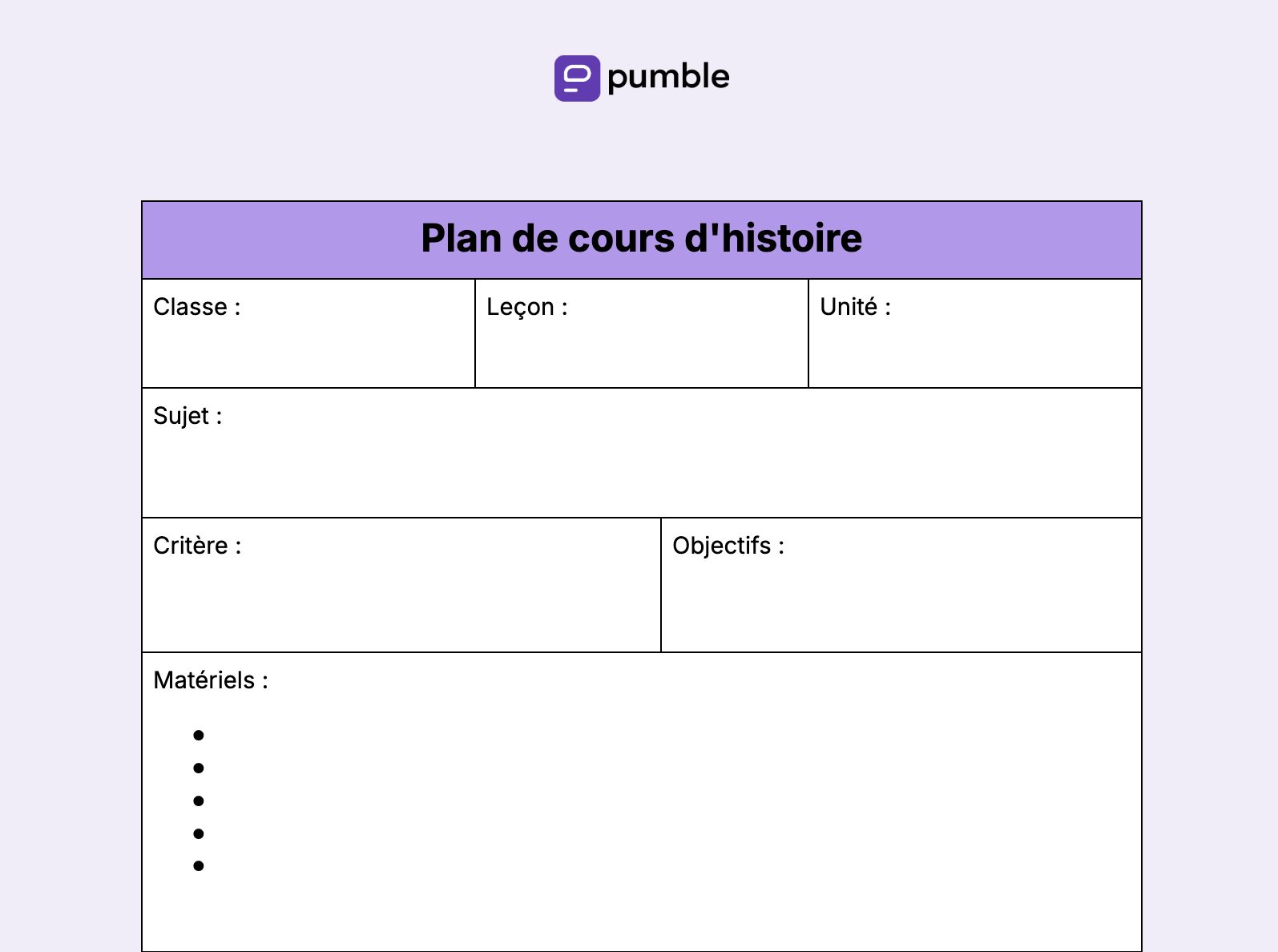
🔽 Télécharger le modèle de plan de cours d'histoire
🔽 Télécharger le modèle de plan de cours d'histoire imprimable
Modèle n° 4 : Modèle de plan de cours de géographie
La géographie est une autre matière qui peut être un peu aride, selon la méthode de présentation de l'enseignant. Pourtant, elle est absolument essentielle à la compréhension du monde par les élèves.
Le modèle de plan de cours suivant vous aidera à vous concentrer sur l'essentiel.

🔽 Télécharger le modèle de plan de cours de géographie
🔽 Télécharger le modèle de plan de cours de géographie imprimable
Discuter sur objectifs avec les membres de la faculté sur Pumble
Modèle n° 5 : Modèle de plan de cours d'anglais
En tant que professeur d'anglais, vous bénéficiez déjà d'une grande variété de thèmes, de sujets et de ressources pour vous inspirer et organiser vos cours d'anglais.
Il ne vous manque plus qu'un plan de cours solide pour organiser tous vos objectifs pédagogiques et vos activités d'apprentissage.
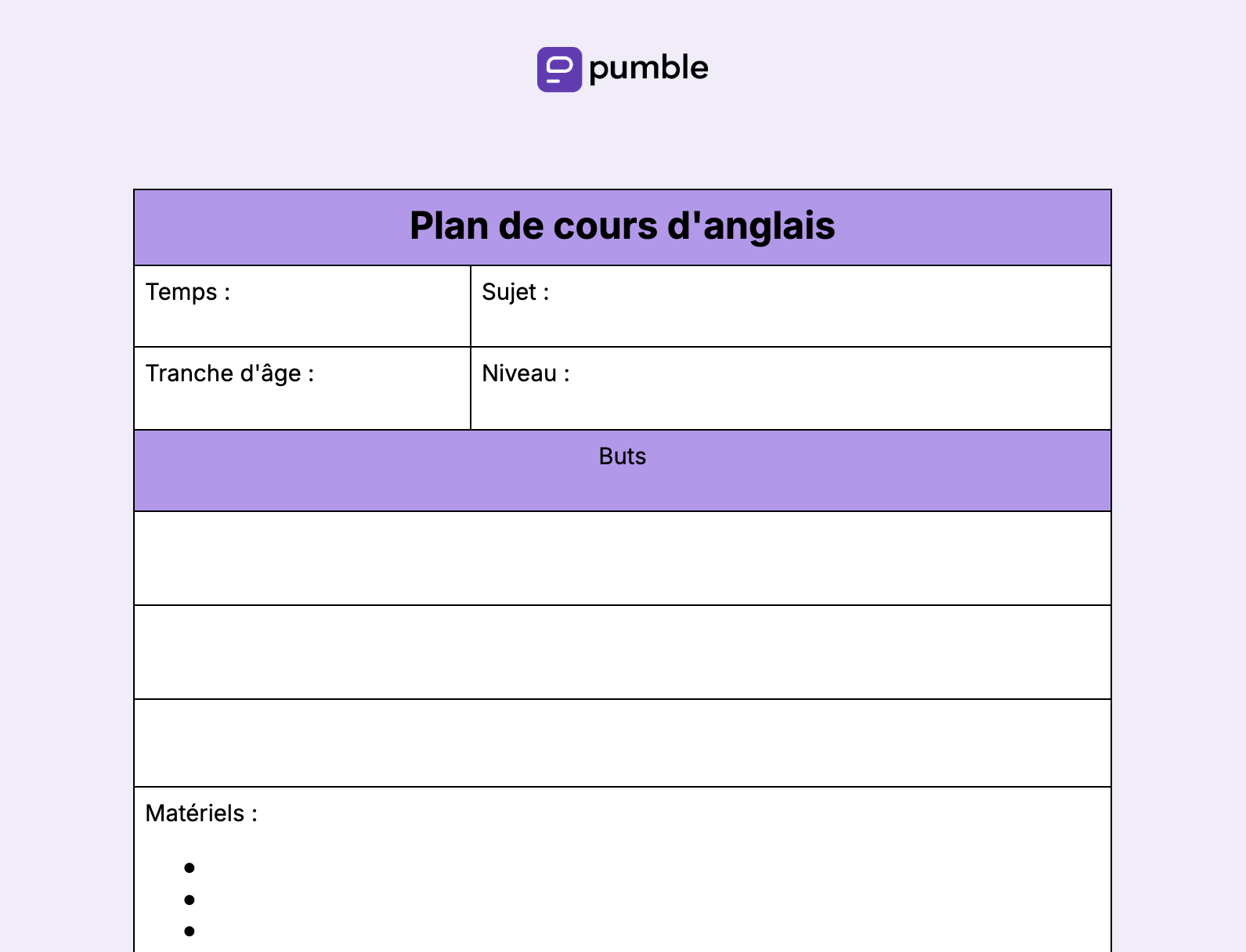
🔽 Télécharger le modèle de plan de cours d'anglais
🔽 Télécharger le modèle de plan de cours d'anglais imprimable
Modèle n° 6 : Modèle de plan de cours de musique
L'un des défis les plus courants pour les professeurs de musique est de rester en bonne voie et de laisser les objectifs pédagogiques spécifiques guider leurs cours, plutôt que de s'écarter complètement du programme et de plonger leurs cours dans la folie.
Pour que vos cours conservent un semblant de structure tout en laissant suffisamment de place à l'improvisation créative, pensez à utiliser notre modèle de plan de cours.
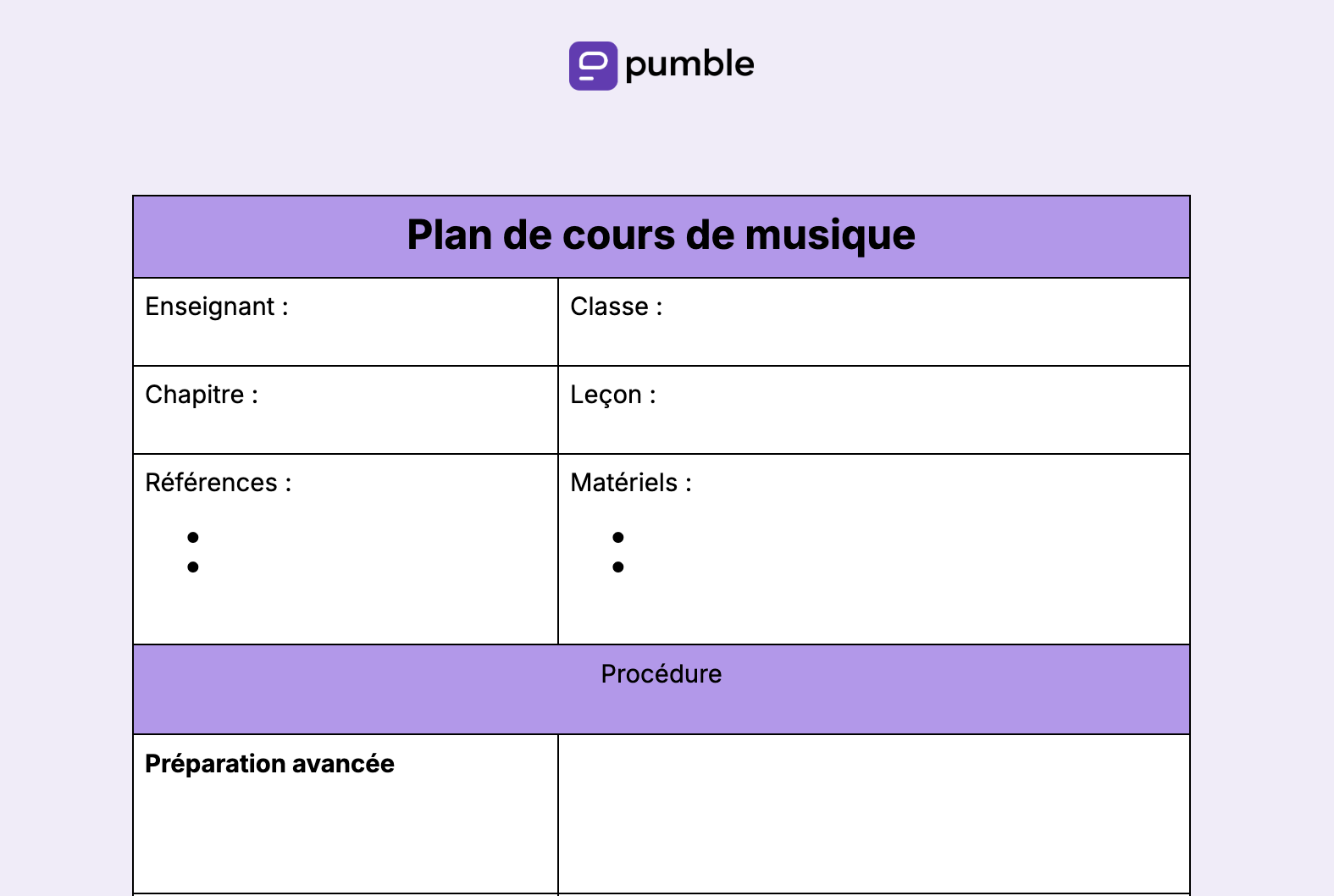
🔽 Télécharger le modèle de plan de cours de musique
🔽 Télécharger le modèle de plan de cours de musique imprimable
Envoyer des messages audio et vidéo avec Pumble
Modèle n° 7 : Modèle de plan de cours d'art
Certains pourraient dire que les professeurs d'art peuvent se permettre de ne pas avoir de plan de cours, mais nous ne sommes pas d'accord.
L'utilisation d'un modèle de plan de cours bien pensé (comme celui ci-dessous) peut simplifier la planification de vos cours et garantir que vos élèves disposent toujours des outils nécessaires pour terminer leurs travaux.
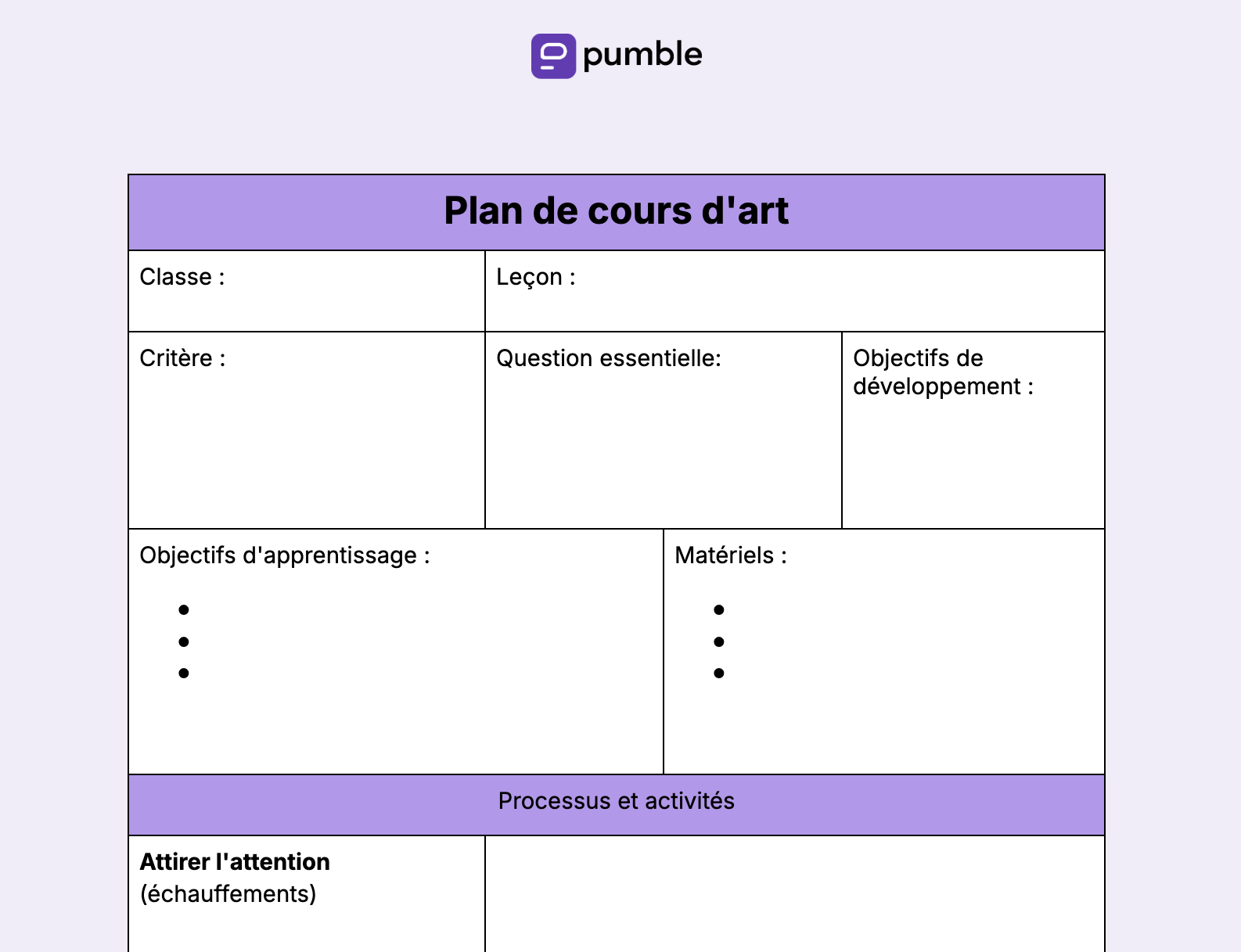
🔽 Télécharger le modèle de plan de cours d'art
🔽 Télécharger le modèle de plan de cours d'art imprimable
Modèle n° 8 : Modèle de plan de cours de biologie
Les professeurs de biologie peuvent rendre leurs cours plus intéressants en intégrant toutes sortes d'expériences, de tests en laboratoire et de projets exploratoires ludiques.
Toutefois, toutes ces activités d'apprentissage stimulantes doivent être planifiées à l'avance ; c'est là que notre modèle de plan de cours pour professeurs de biologie peut s'avérer utile.
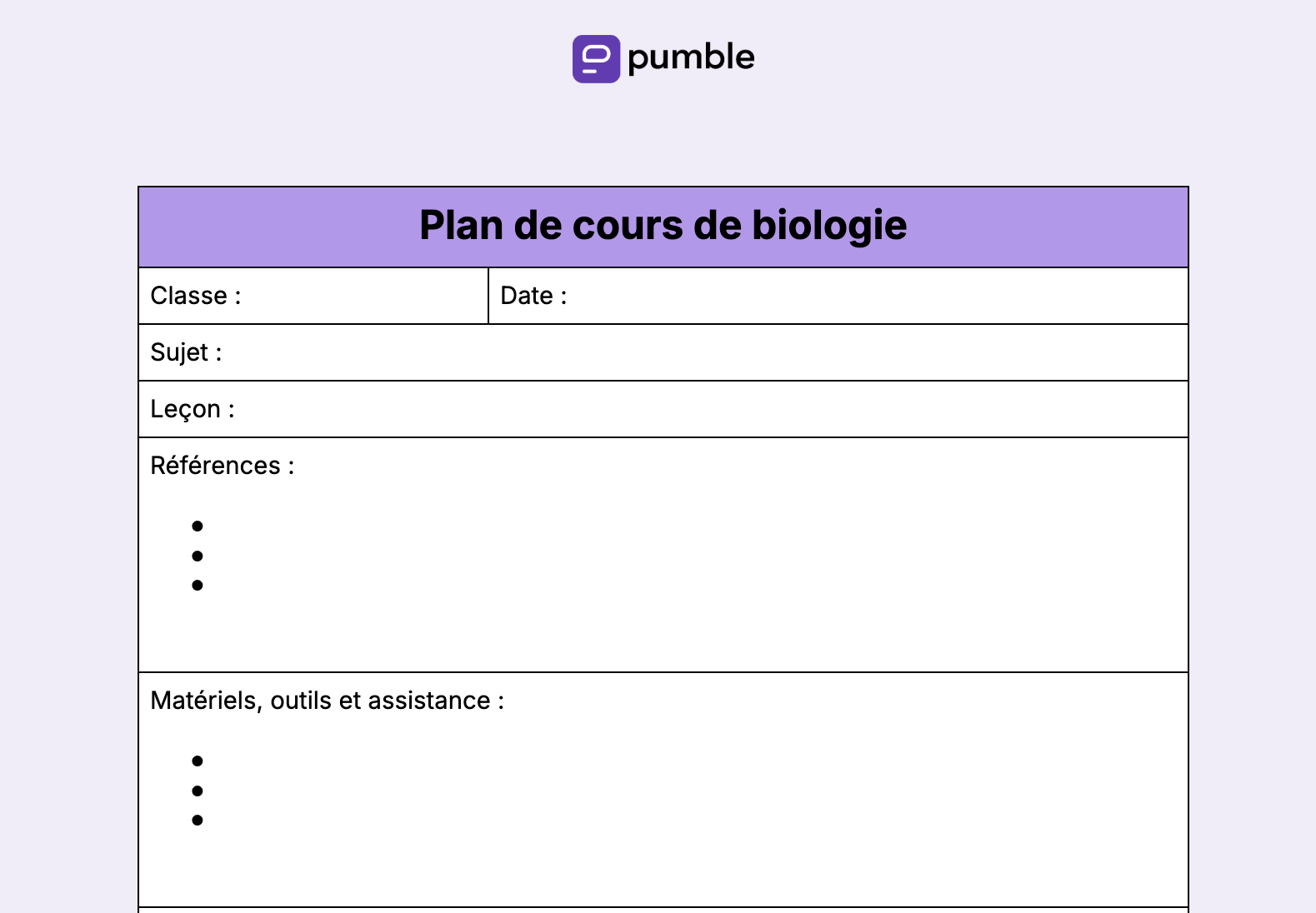
🔽 Télécharger le modèle de plan de cours de biologie
🔽 Télécharger le modèle de plan de cours de biologie imprimable
Coordonner avec les autres membres de la faculté via Pumble
Modèle n° 9 : Modèle de plan de cours de théâtre
Planifier vos cours de théâtre est à la fois très enrichissant et créatif, mais cela peut aussi s'avérer complexe.
Notre modèle de plan de cours de théâtre modifiable vous permet de vous concentrer sur vos objectifs pédagogiques sans compromettre le plaisir de vos élèves.
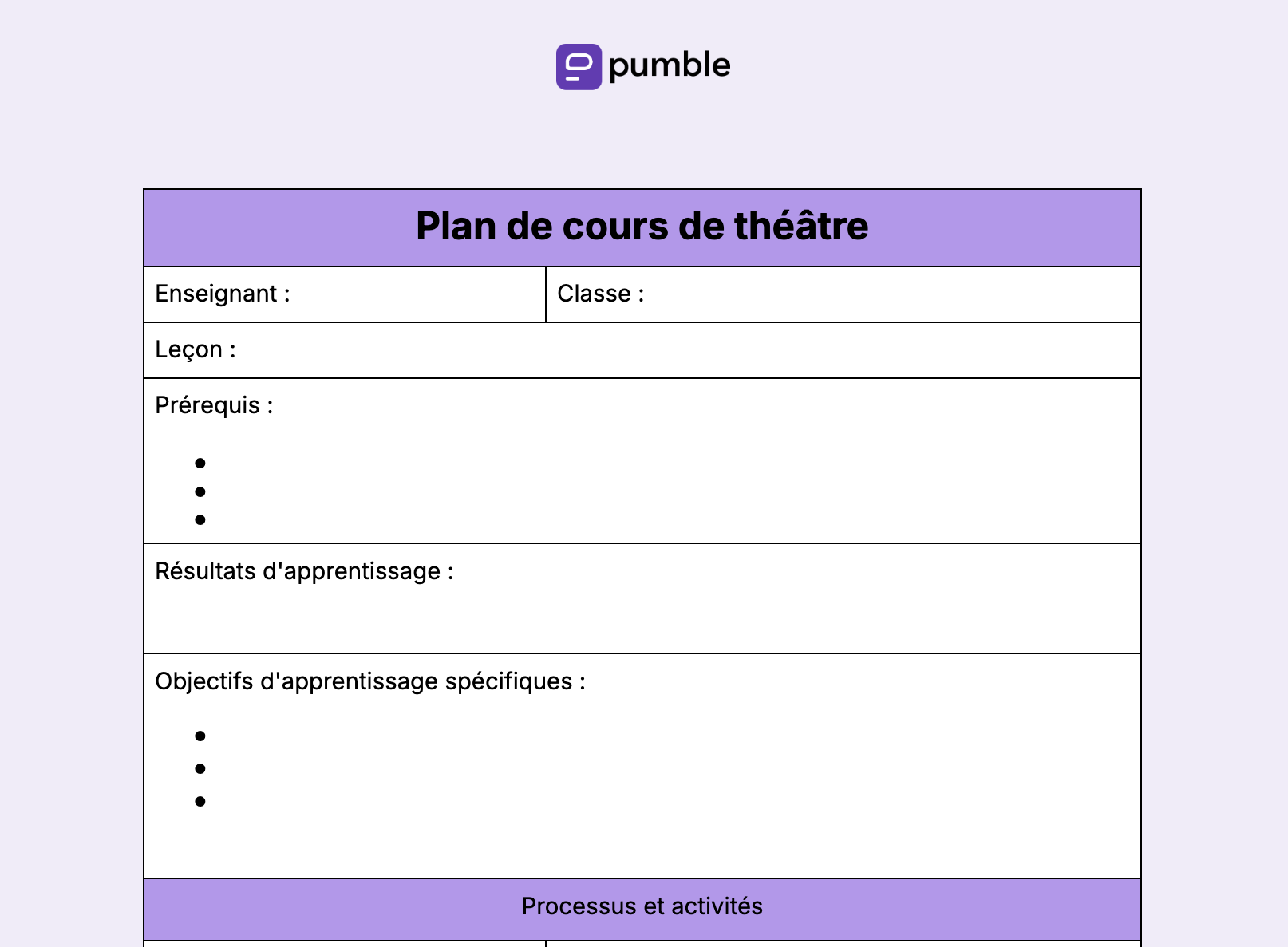
🔽 Télécharger le modèle de plan de cours de théâtre
🔽 Télécharger le modèle de plan de cours de théâtre imprimable
Modèle n° 10 : Modèle de plan de cours d'EPS
L'éducation physique et sportive est une autre matière qui peut être difficile à quantifier et à adapter aux capacités de chaque élève.
Cependant, ce n'est pas parce qu'elle est difficile qu'elle est impossible. Consultez notre modèle de plan de cours d'éducation physique et sportive pour avoir une idée de ce à quoi peut ressembler un plan de cours individuel.
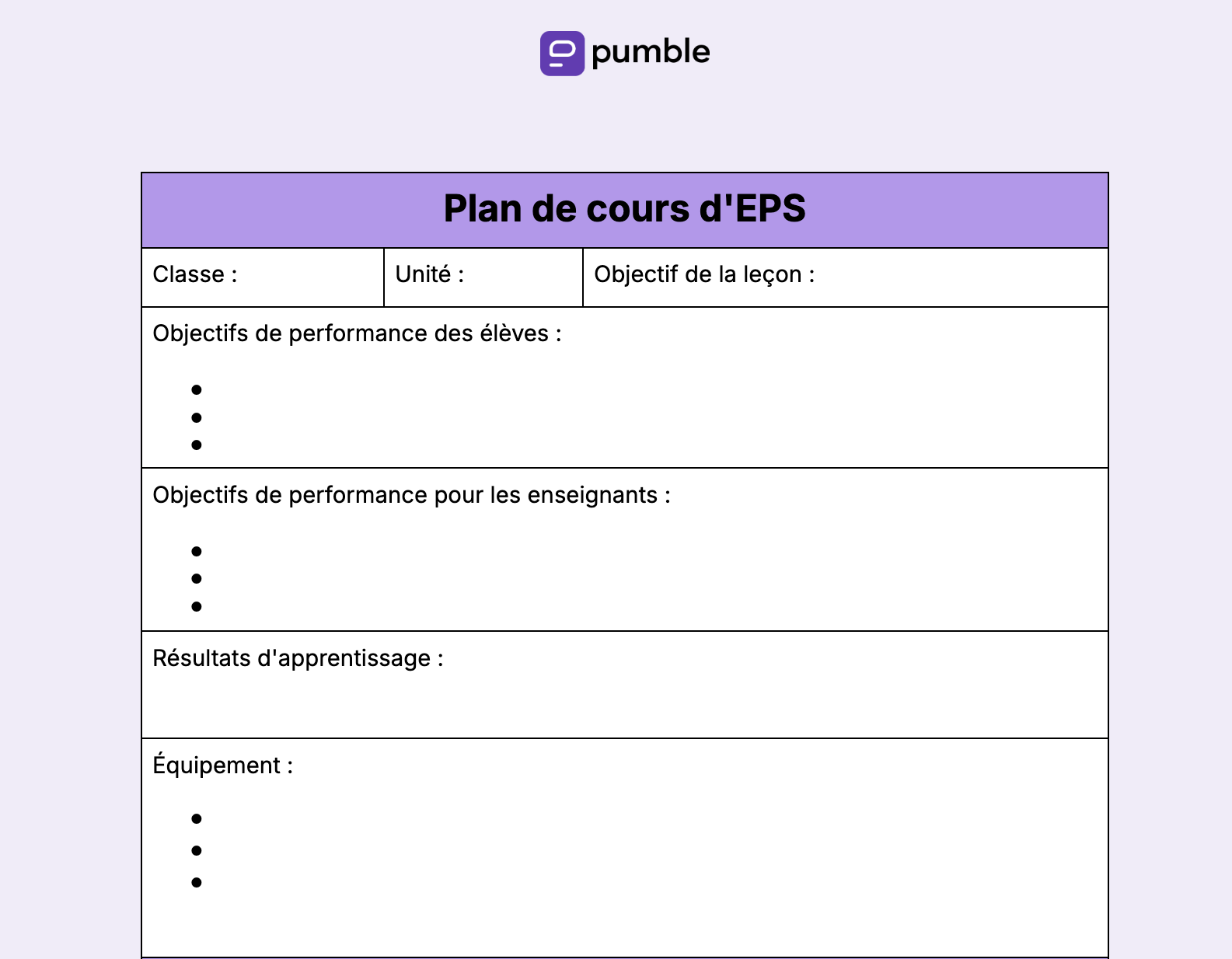
🔽 Télécharger le modèle de plan de cours d'EPS
🔽 Télécharger le modèle de plan de cours d'EPS imprimable
Comment créer un modèle de plan de cours
Maintenant que nous vous avons donné presque tous les exemples de plans de cours existants, nous souhaitions découvrir comment les experts créent des modèles de plans de cours ou les adaptent à leurs besoins.
Voyons leurs conseils !
Conseil n° 1 : Fixez-vous des objectifs et un calendrier réalistes
N'oubliez pas que la dynamique de classe n'est pas une variable fixe et qu'aucune bonne intention ne vous permettra d'atteindre l'objectif principal ou l'activité si vous avez mal calculé le temps de l'échauffement, par exemple.
Bien sûr, la définition d'objectifs réalistes dépend principalement de votre expérience en tant qu'enseignant. Cependant, même les enseignants les moins expérimentés peuvent viser la simplicité et des objectifs réalistes.
En cas de doute sur les estimations de temps, il est conseillé de prévoir plus de temps que nécessaire. Selon notre collaborateur, Christopher Hathaway, conseiller en préparation à l'université, il est préférable de toujours « prévoir plus de temps que nécessaire ».
Il précise :

« Il vaut mieux manquer de temps après avoir captivé les élèves du début à la fin plutôt que de se démener pour trouver de quoi remplir le temps restant. Les élèves savent flairer les tâches futiles. »
D'autre part, certains experts, comme Haley DeSousa, conseillent aux enseignants d'éviter la sur-planification :

« Laissez de la place dans votre emploi du temps et votre matériel pour que les enfants prennent les choses en main. Les meilleurs apprentissages se produisent souvent dans des moments imprévus. »
Si vous organisez vos cours dans une classe virtuelle via un logiciel de communication interne comme Pumble, vous pouvez laisser vos élèves prendre les devants en les invitant à lever la main pendant le cours, comme l'illustre l'image ci-dessous.

Utiliser les appels vidéo Pumble pour organiser des cours captivants
Conseil n° 2 : Maintenez les cours centré sur les élèves
Pour stimuler l'engagement et la productivité de vos élèves, Haley DeSousa recommande d'adopter une approche centrée sur l'élève lors de la planification des cours :

« Commencez par l'enfant, et non par le programme. Observez les élèves attentivement pour comprendre ce qui capte leur attention et faites les activités selon leurs intérêts. Cela permet de transformer un modèle générique en un outil pertinent.»
À cet effet, Christopher Hathaway ajoute que les enseignants devraient également tenir compte de l'impact du timing de leur cours sur l'attention et la productivité des élèves :

« Soyez attentifs aux horaires de cours et comprenez l'impact de ce timing sur les élèves. S'agit-il de la première période où certains enfants ont encore un pied au lit, ou la dernière, où ils sont déjà à bout de nerfs ? Soyez toujours conscient du travail à accomplir, mais restez attentif aux besoins des élèves et soyez prêt à les impliquer différemment avec des exercices ponctuels (pertinents) si nécessaire. »
Conseil n° 3 : Assurez-vous que vos plans de cours soient clairs et faciles à suivre
Un autre conseil important à garder à l'esprit lors de la création de plans de cours : ils doivent être pertinents non seulement pour vous, mais aussi pour les autres.
Par exemple, vous pourriez décider de changer de poste ou de prendre un congé maladie prolongé.
Dans les deux cas, vous souhaitez que votre remplaçant puisse reprendre là où vous vous êtes arrêté et offrir à vos élèves l'éducation qu'ils méritent.
Suivre un plan de cours cohérent et conserver une trace des plans de cours précédents facilitera grandement la transition pour toutes les personnes concernées.
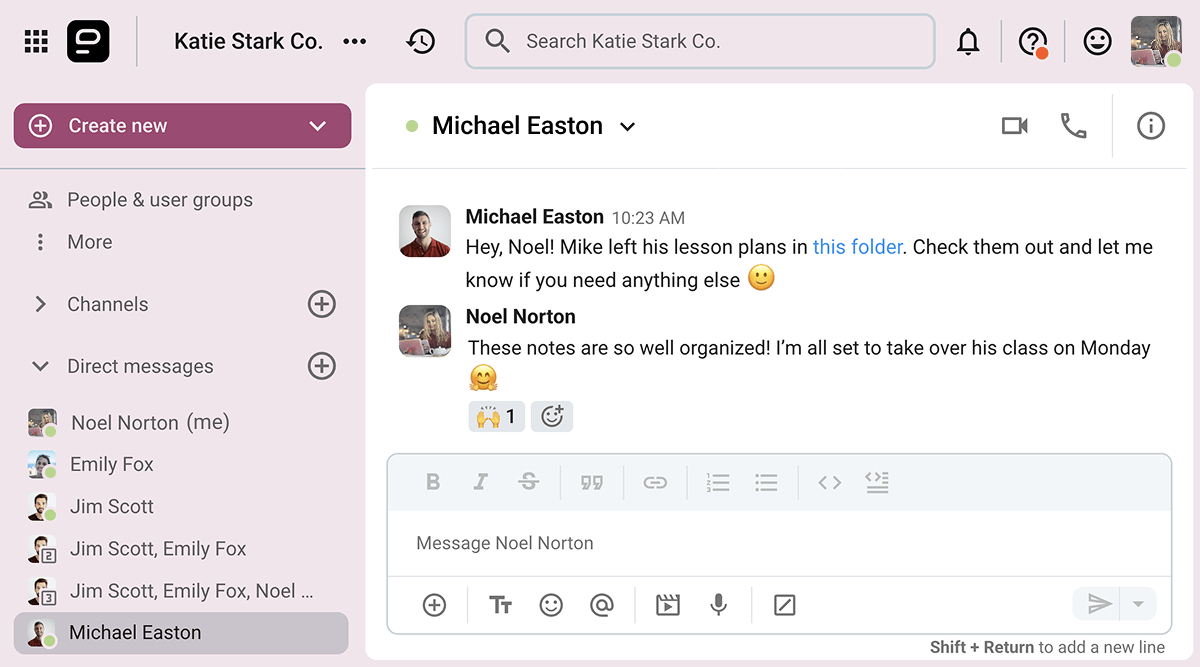
Intégrez facilement de nouveaux enseignants avec Pumble
Conseil n° 4 : Remplissez le modèle autant que possible
Si vous utilisez des modèles de plan de cours, il est important de le faire correctement.
Prenez le temps de remplir le modèle de plan de cours que vous avez choisi et ajustez-le à votre goût.
En peaufinant les moindres détails de votre cours à l'avance, vous vous préparez aux éventuels contretemps et, paradoxalement, vous vous sentez plus à l'aise pour analyser la salle et improviser sur place si l'occasion se présente de dévier du script.
Après chaque cours, réfléchissez et révisez votre modèle de plan de cours pour référence ultérieure, comme le conseille Haley DeSousa :

« N'oubliez pas les choses qui ont fonctionné, ce qui n'a pas fonctionné et les nouvelles questions qui ont émergé. Cela permet de maintenir un processus de planification dynamique et centré sur l'enfant. »
Savoir que vous pouvez toujours revenir à votre structure initiale vous donne la confiance nécessaire pour explorer différentes stratégies et activités d'apprentissage.
Conseil n° 5 : Établissez une routine.
Créer des plans de cours demande du temps et de l'énergie, que vous préféreriez sans doute consacrer à profiter de votre temps libre plutôt qu'à préparer votre travail.
C'est pourquoi il est primordial de faire le nécessaire pour vous motiver à inclure cette activité dans votre emploi du temps hebdomadaire.
Instaurez une routine consistant à réserver volontairement du temps chaque semaine pour vous concentrer sur l'élaboration de vos plans de cours.
Une façon de faciliter l'élaboration de cette routine serait d'éviter de proposer des activités d'apprentissage créatives pour chaque leçon et de privilégier la simplicité, comme nous l'a expliqué Annie Jenson :

« Si les expériences d'apprentissage créatives peuvent être stimulantes, elles ne sont pas toujours viables au quotidien (ni toujours dans l'intérêt de l'apprentissage des élèves). C'est pourquoi nous privilégions des structures réfléchies et cohérentes qui soutiennent à la fois les enseignants et les élèves. »
En un rien de temps, la planification des cours deviendra une tâche routinière, et vous constaterez qu'elle deviendra plus facile et moins chronophage au fil du temps.
Conseil n° 6 : Laissez place à l'improvisation
Enfin, il est important de garder à l'esprit que, bien que cruciaux, les plans de cours ne constituent pas la solution ultime à l'enseignement.
S'il est essentiel d'avoir une structure de cours détaillée et fiable, il est tout aussi important de maintenir une planification flexible et d'être prêt à suivre le rythme de la classe.
En effet, savoir observer et s'adapter à ses élèves est une compétence essentielle pour les enseignants à l'ère du numérique, selon Annie Jenson :

« À l'ère du numérique, la capacité d'attention, les préférences d'apprentissage et les objectifs pédagogiques des élèves diffèrent souvent considérablement de ceux des générations précédentes. Par conséquent, les enseignants doivent être capables de répondre aux divers besoins des apprenants d'aujourd'hui. »
N'oubliez donc pas d'adapter vos plans de cours aux besoins et aux capacités de chaque élève.
Planifiez efficacement vos cours et atteignez vos objectifs pédagogiques avec Pumble
Une planification efficace des cours est essentielle pour que les enseignants puissent proposer des expériences d'apprentissage stimulantes et percutantes. Les modèles proposés dans cet article constituent des ressources précieuses pour simplifier le processus de planification et répondre à la diversité des besoins pédagogiques.
Cependant, même avec des modèles complets, la collaboration et la communication entre enseignants et élèves restent essentielles. C'est là qu'interviennent des outils comme Pumble, une application de communication pour les enseignants.
Pumble de CAKE.com est une application de communication d'équipe dotée d'une interface intuitive et de fonctionnalités performantes. Elle facilite la collaboration entre enseignants et élèves, leur permettant de partager des idées, des ressources et des commentaires en temps réel ou de manière asynchrone.
Pumble vous permet de :
- Envoyer des messages directs aux responsables pédagogiques ou aux étudiants si nécessaire,
- Séparer les communications avec les enseignants de celles avec les étudiants grâce à des canaux privés et publics,
- Organiser vos communications dans des fils de discussion distincts,
- Partager des fichiers comme vos modèles de plans de cours avec d'autres enseignants et même avec les étudiants, grâce à la grande capacité de stockage de Pumble,
- Organiser des cours virtuels et partager votre écran avec vos étudiants,
- Demander aux étudiants d'utiliser des rappels pour suivre leurs devoirs.
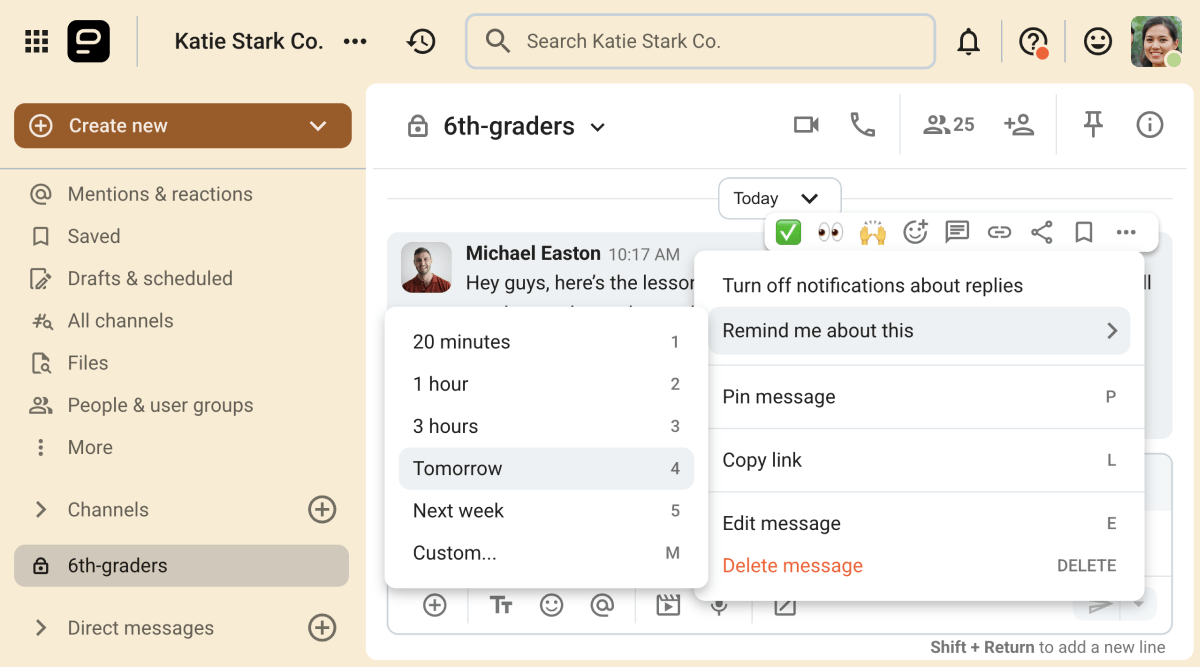
Avec Pumble, les enseignants peuvent optimiser et améliorer leur processus de planification des cours en favorisant la collaboration, en gagnant du temps et, au final, en augmentant la qualité de l'enseignement pour leurs élèves.
Inscrivez-vous à Pumble aujourd'hui
Comment nous examinons cet article : Nos rédacteurs et éditeurs vérifient les articles et les mettent à jour lorsque de nouvelles informations sont disponibles, afin qu'ils soient toujours d'actualité.

